|
On July 14, 1901, the Tampa Tribune
announced that
Louise Frances Dodge
of Ann Arbor, Michigan, had reached
Tampa and joined the Tribune.
Described as a versatile writer and a
newspaper woman of experience, "her
work will be especially appreciated by
the lady readers of the Tribune."
Her new feature, "Our People and
Others," was first published in July
1901 and appeared on the society page
each Sunday edition. Miss Dodge
soon won recognition by her brilliant
writings, her charming personality, and
her qualities of leadership and
initiative.
In April of 1902, Louise began a daily
society page feature titled "Womans*
Ways and Wishes." Two months
later she inspired and organized the
Student Art Club along with Mrs. C. C.
Martin and was joined by several other
society women and students of art,
electing Mrs. M. L. Douglass as its
first president.
In 1923
the Tampa Art Institute was formed when
the Students Art Club and the Tampa
Museum of Fine Arts were combined.
*Yes, singular and no apostrophe.
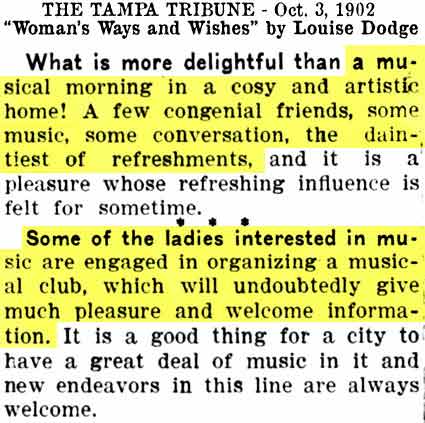 In
early Oct. 1902, Louise urged the
creation of a music club which would be
named "The Friday Morning
Musicale."
She was encouraged in her efforts by
Mrs. Conoley and Mrs. Weller
who referred her to
Mrs. W. H. Ferris, an outstanding music
teacher and organist for St. Andrew’s
Episcopal Church. Together, Louise and
Mrs. Ferris started a club of music
lovers with Mrs. W. H. Ferris as its
first and only president for its first
23 years. The organization
continues in Tampa to this day
(2024) In
early Oct. 1902, Louise urged the
creation of a music club which would be
named "The Friday Morning
Musicale."
She was encouraged in her efforts by
Mrs. Conoley and Mrs. Weller
who referred her to
Mrs. W. H. Ferris, an outstanding music
teacher and organist for St. Andrew’s
Episcopal Church. Together, Louise and
Mrs. Ferris started a club of music
lovers with Mrs. W. H. Ferris as its
first and only president for its first
23 years. The organization
continues in Tampa to this day
(2024)
The club's meetings opened with a roll
call to which members responded with
bits of musical news, usually about the
composer or topic of the meeting.
A report was read about the chosen
composer’s life or topic and was
followed by four musical numbers
selected from the composer’s works or of
the type of music being studied. The
Musicale later also categorized members
into musical departments - piano,
soprano, contralto and chorus. As the
club expanded, additional departments
were added including violin, orchestra
and organ.
WHO WERE MR. & MRS. W. H. FERRIS?
Mrs. W. H. Ferris appeared in newspaper
articles hundreds of times in Tampa,
from 1900 to 1924, due to her musical
talent--church organ performances, piano
performances, wedding and funeral
performances, social events, church
events, and travels.
In her lifetime, she was always referred
to in the newspapers as "Mrs. W. H.
Ferris" except for two mentions as
"Mrs. William H. Ferris."
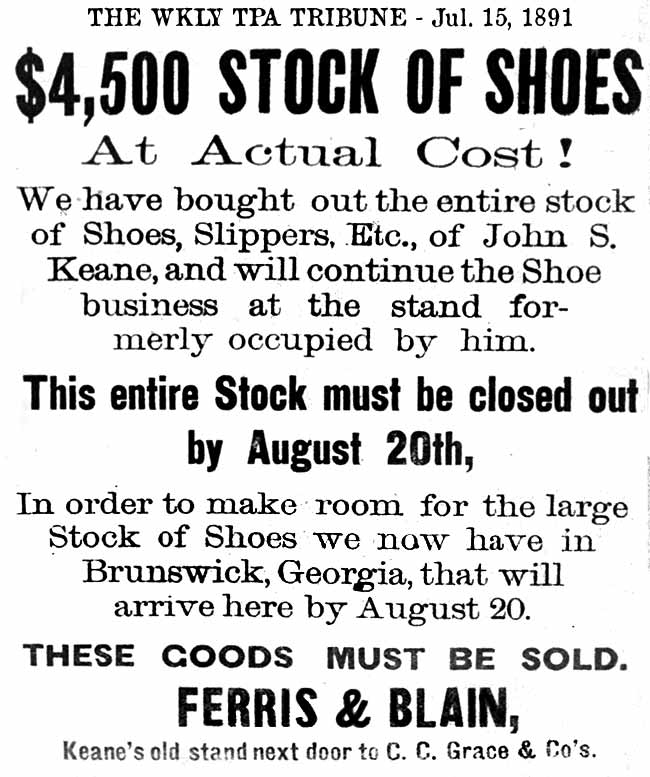
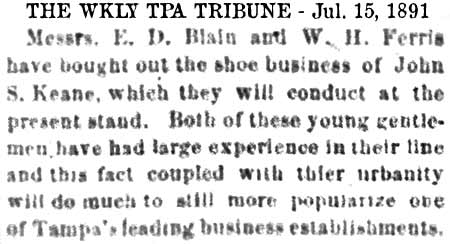
Her husband, W. H. Ferris, was
co-owner of a successful shoe business
in Tampa, which started in July 1891
when he and Eugene Blain bought the
inventory of John Keane.
Their first ads were to get rid of
Keane's inventory.
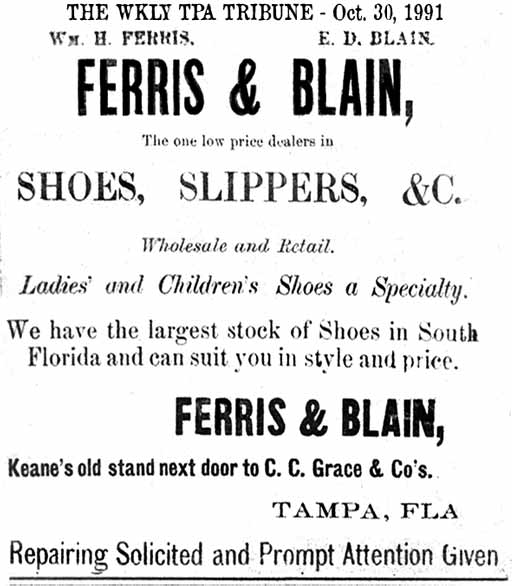
Later, more creative shoe store ads
appeared in the newspapers almost daily
from 1891 to 1899.
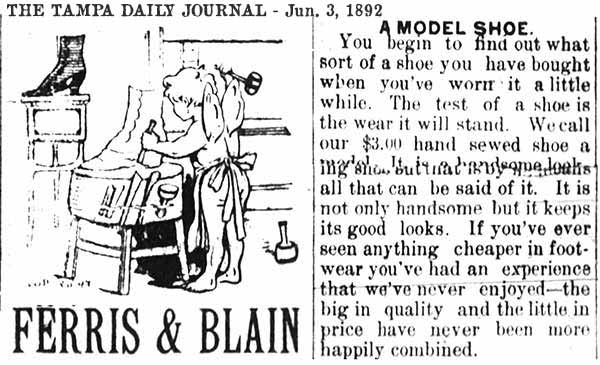
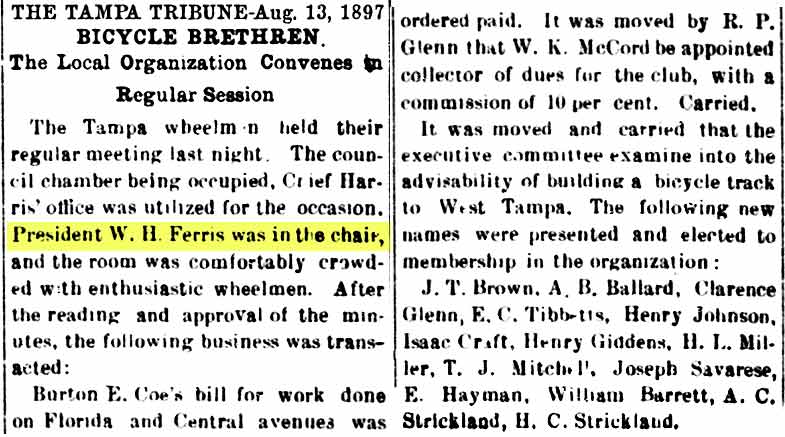 But
personally, W. H. Ferris was mentioned
only a handful of times in articles from
the mid 1890s to 1902 about his business
travels and his efforts in organizing
the Tampa Wheelmen's bicycle club for
which he was its first president. But
personally, W. H. Ferris was mentioned
only a handful of times in articles from
the mid 1890s to 1902 about his business
travels and his efforts in organizing
the Tampa Wheelmen's bicycle club for
which he was its first president.
Mr. and Mrs. Ferris were mentioned in
the newspaper together only ONCE
in their lifetimes.
The article at right describes a
Wheelman's meeting in Chief Harris's
office. He was A. J. (Andrew
Jackson) Harris, Tampa's popular fire
chief.
His
office, as well as Fire Station 1, was
located in the old old City Hall that
was built in 1890 and demolished in
1915.
Read more about A. J. Harris.
Read more about this first City Hall
building.
Read about the details concerning its
construction.
|
MRS. W.H. FERRIS WAS KATHERINE
ELIZABETH CRAIG
Mrs. W. H. Ferris was Katherine
Elizabeth Craig. She was born Sep.
6, 1870 in Orrville, Ala. to parents
Emmet E. Craig & Mary Norman Kittrell.**
|
|
*Information given
on Kate's death certificate provided by
her daughter shows "Kitchener" as her
mother's maiden name but online research
of her family tree shows several records
sources showing Kittrell.
1870 Census, Dallas County, Orrville,
Ala.
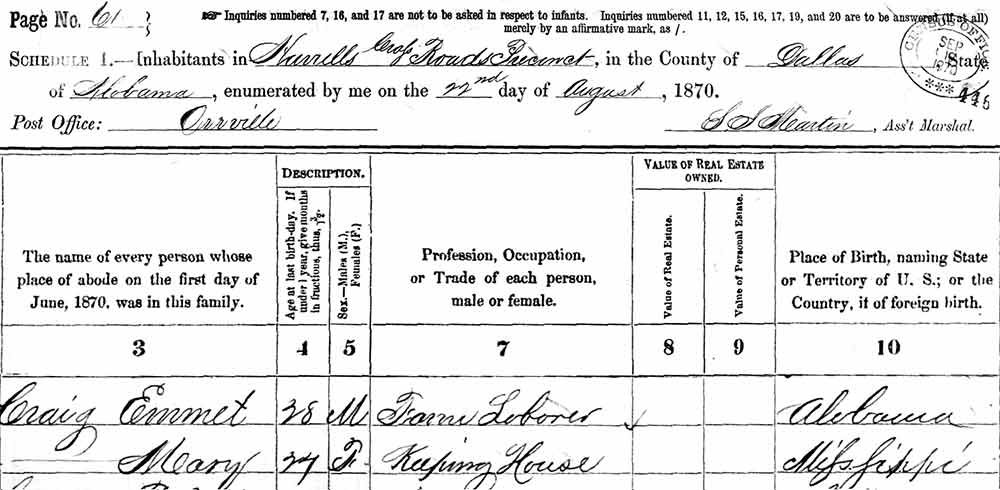
Katie was born in Orrville, Dallas Co.,
Ala. fifteen days after this census was
taken. On this page, almost all
the adult males were farm laborers and
none had any values recorded for their
real estate or personal property.
By 1880, the Craigs had moved to Hunt
Co., TX and Emmet had become a grocer.
Hunt County borders Dallas County on the
northeast of the Dallas-Ft. Worth metro
area and its county seat is Greenville.

Emmet Craig (36) was a grocer on the
1880 Census of Hunt Co., TX. Wife
Mary (Kittrell) Craig was 36, with
children Katie (9) and Norman W. Craig.
(8) both born in Alabama. The
census date was June 1, 1880, so Katie
would turn 10 that September resulting
in an 1870 birth year.
Emmet Craig died in April of 1891.
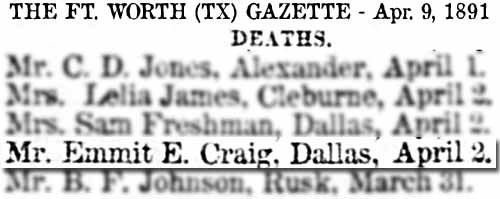
|
WHEN WAS KATE CRAIG IN
TAMPA & HOW DID SHE MEET WM.
H. FERRIS?
In late December 1893,
Kate Craig traveled from
Texas to visit with her
uncle and aunt in Tampa--
Judge & Mrs. Barron Phillips.
A reception was held at the
Phillips home at which "A
number of our most prominent
society young people were
present." No doubt
that William H. Ferris was
present, being a successful
shoe business owner and
grandson of Ft. Brooke/Tampa
pioneer merchant William G.
Ferris Sr. (who was still
living at the time.)
Kate was 23 at the time,
William H. Ferris was 26.
No evidence has been found
that Kate had visited Tampa
earlier.
Mrs. Barron Phillips was
Elizabeth Craig Phillips,
sister of Kate's father
Emmet E. Craig.
Their parents were James
Woodburn Craig
(1817-1880) and
Catherine Quarles
(1820-1896).
Judge Phillips and wife
Elizabeth Craig were parents
of William Sidney Phillips
(1879), James Craig Phillips
(1881), and Kathleen
Phillips (1883). These
were Kate's cousins. (Some
info
from Find a Grave; Catherine
Elizabeth Craig Phillips -
Phillips family Oaklawn
cemetery plot) |
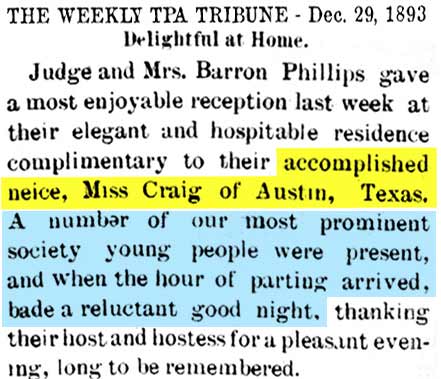 |
|
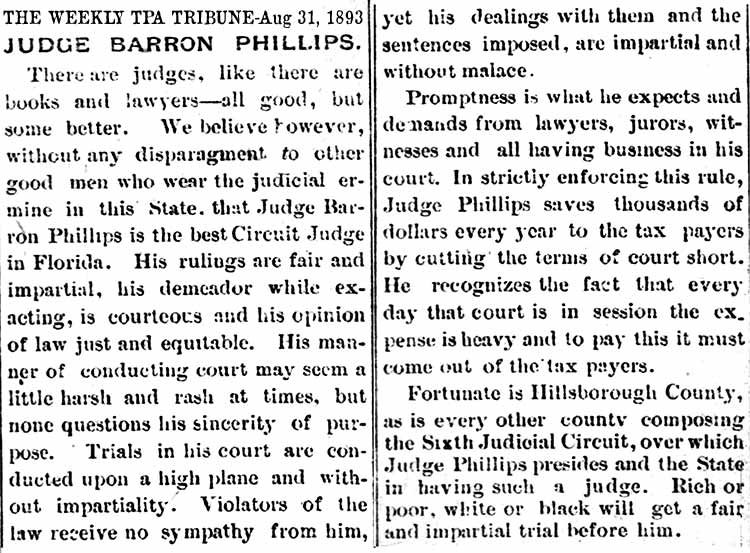 |
Judge Barron Phillips was
Kate's uncle by his marriage
to Elizabeth Craig, Kate's
aunt.
Barron Phillips
married Catherine Elizabeth
"Betty" Craig on May 11,
1876 in Dallas Co., Alabama.
Judge
Phillips died in Tampa on
May. 1, 1904.
Read about his life in his
obituary.
Mrs. Phillips died in
Ashvelle, NC on Sep. 15,
1930.
Read her obits.
|
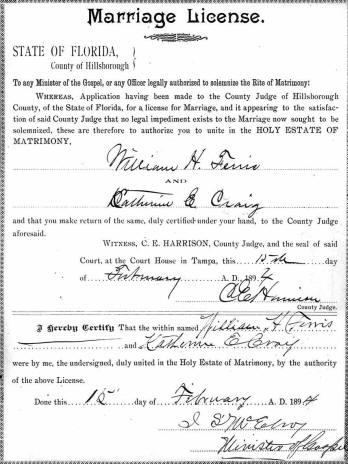
"Kate" as she was known socially,
married William H. Ferris in Tampa on
Feb. 15, 1894. It was six
weeks after they met.
Their marriage license shows Kate's
first letter of her first name was
written over due to first misspelling
with a "C" instead of a "K." In
her own signature, it is a "K."
|
|
WHO WAS W. H. FERRIS?
W. H. Ferris was William Houston
Ferris
(hereafter sometimes referred to as
WHF), a grandson of Tampa pioneer
merchant William Gould Ferris, Sr.
(WGF-1) and wife Eliza Morris.
WHF's middle name Houston was his
maternal grandmother's maiden name.
THE FERRIS FAMILY OF TAMPA PIONEERS
Below is mostly from the
Sunland Tribune Vol. 22,
1996 "Tampa
Is The Place of Places"
by Kyle Vanlandingham, at
USF Library Digital Commons.
Italics portions have
been added by TampaPix.
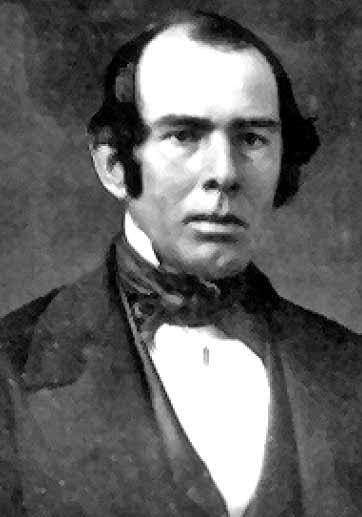 |
William Gould Ferris,
(Sr.)
was the founder of one of
Tampa’s leading nineteenth
century pioneer families.
Born June 11, 1810 in Ovid,
New York, he was the eldest
of five children of Josiah
and Lydia (Bangs) Ferris. As
a young man, WGF-1
went to the Choctaw Indian
Nation Territory (Hempstead
County, Arkansas), and was
married there on June 4,
1834 to Eliza Morris, a
native of Fort Wayne, Ohio. (Her
1850 & 1860 censuses clearly
show Louisiana. Her
1870, 1880 and 1885 censuses
show Ohio.) WGF-1
arrived at Fort Brooke
(Tampa) from Arkansas in
1841, He was employed
by the U. S. Army and soon
received orders from a ship
in the bay which transferred
him to East Florida. (This
was the Florida Territory;
Fla. was not yet a state
until Mar. 3, 1845.)
The following year, in 1842,
he returned with his family
to settle at Fort Brooke,
where he served as acting
paymaster and
sutler
to the troops. WGF-1
soon opened a general
merchandise and clothing
store which was washed away
during the
great hurricane of
1848. He then built
another store on the south
side of Whiting Street which
he operated until 1857, when
he moved the store to the
northeast corner of
Washington and Monroe
Streets (now Florida Ave.)
because it was determined to
be on Federal Government
property. The Fort
Brooke northern boundary was
Whiting St. |
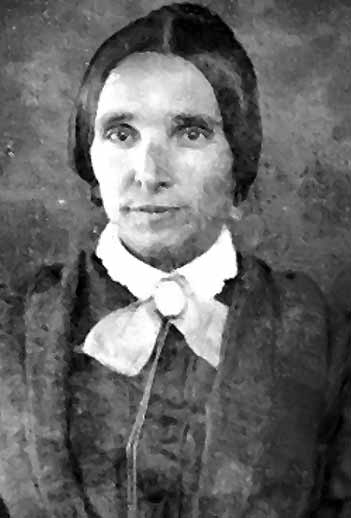 |
|
William
G. Ferris, Sr.
1810 - 1895
Photo courtesy of Sunland
Tribune Vol. 22, 1996 "Tampa
Is The Place of Places"
by Kyle Vanlandingham. |
Eliza
Morris Ferris
1817 - 1891
Photo courtesy of Sunland
Tribune Vol. 22, 1996 "Tampa
Is The Place of Places"
by Kyle Vanlandingham. |
|
LOCATION OF W. G. FERRIS'
STORE IN 1852
Map key and description has
been repositioned in order
to show a larger
representation of Tampa and
the fort structures.
Courtesy of the National
Archives
Mouse over the map to see
close up of Ferris' store
location.
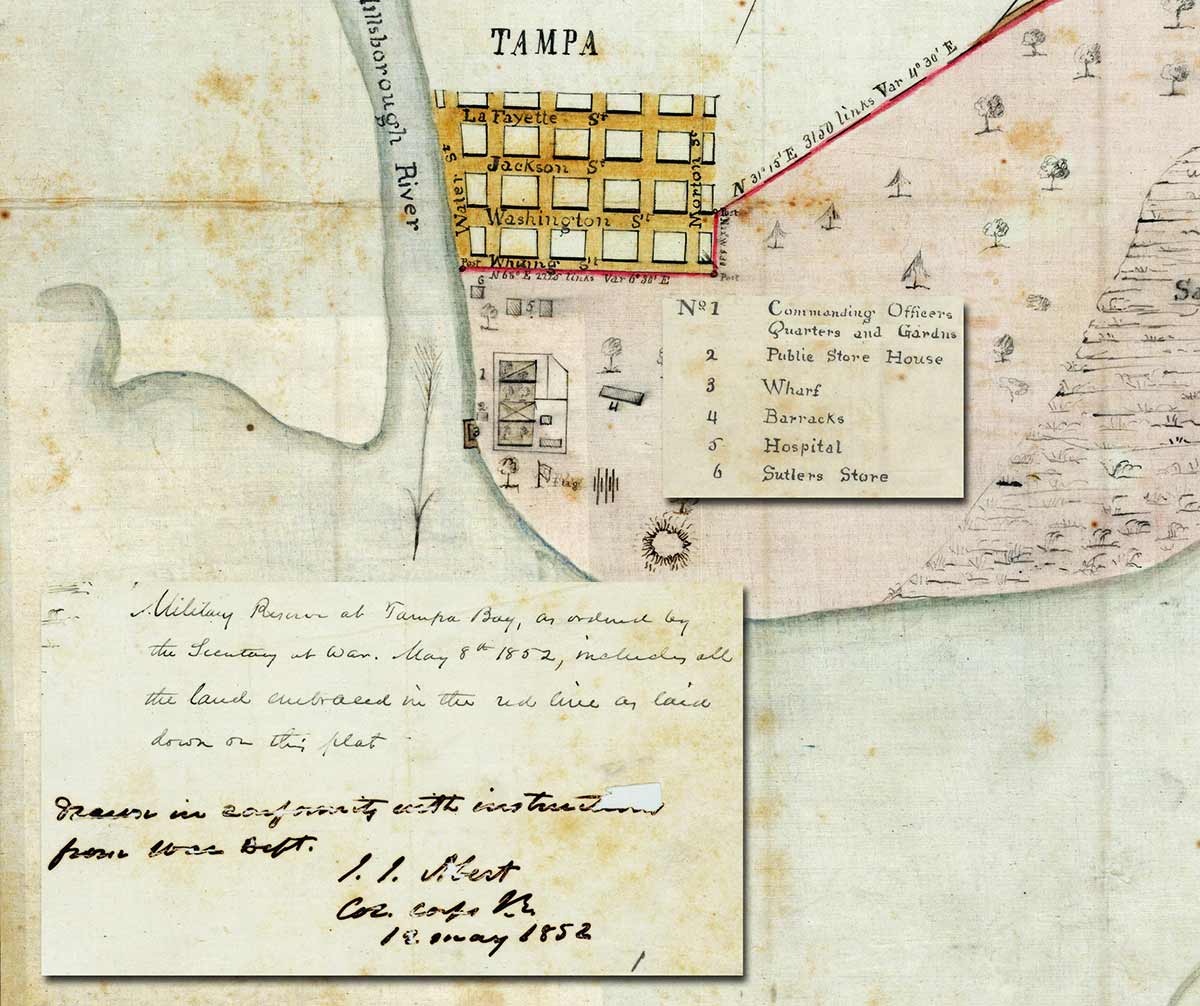
See the larger, uncropped
map showing the entire Fort
Brooke reservation as it
appears on the original map. |
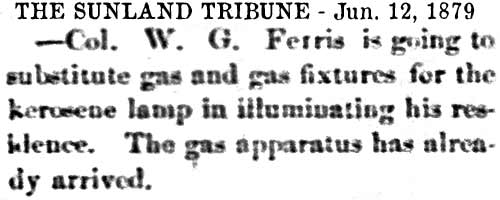 In
Dec. 1866, his son Josiah
Ferris became Acting Mayor
of Tampa until Mar. 1869,
being City Council president
at the time Tampa Mayor E.
A. Clarke left Tampa. In
Dec. 1866, his son Josiah
Ferris became Acting Mayor
of Tampa until Mar. 1869,
being City Council president
at the time Tampa Mayor E.
A. Clarke left Tampa.
Always the trailblazer, Col.
Wm. G. Ferris was reported
by the Sunland Tribune in
June 1879 as converting the
lighting of his residence
from kerosene to gas.
In 1880, his son Henry
Clarke Ferris was elected
Mayor of Tampa. (See
newspaper articles in Henry
Clarke Ferris section
below.) |
1855 FERRIS & SON AD IN THE FLORIDA
PENINSULAR
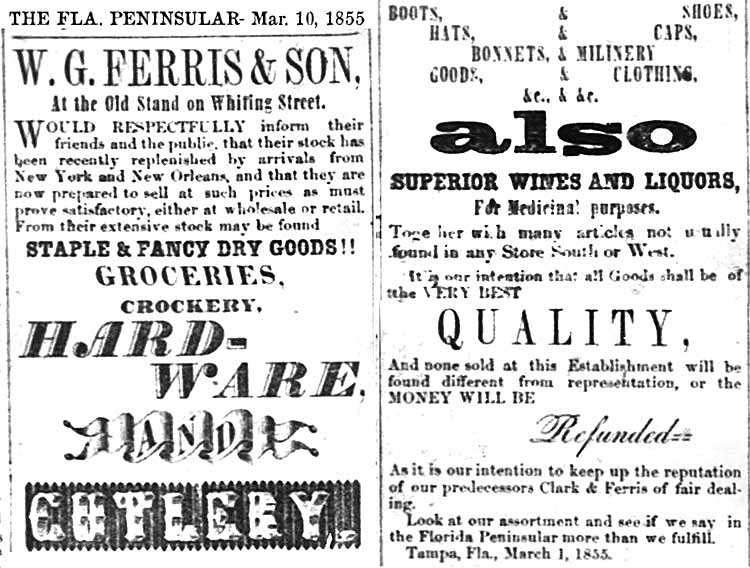
"SUPERIOR WINES AND
LIQUORS" (for medicinal
purposes.)
The July 31, 1890 issue of
the Tampa Journal printed a
page of descriptions of
various Tampa merchants and
their backgrounds.
Ferris came to Tampa in 1842
and was in business by 1843.
His son Josiah assisted in
the business as well.
Before the early 1880s,
Ferris received his goods by
sea from New York, but after
H.B. Plant finally connected
the railroads to Tampa
in 1884, he has had them
shipped by rail.
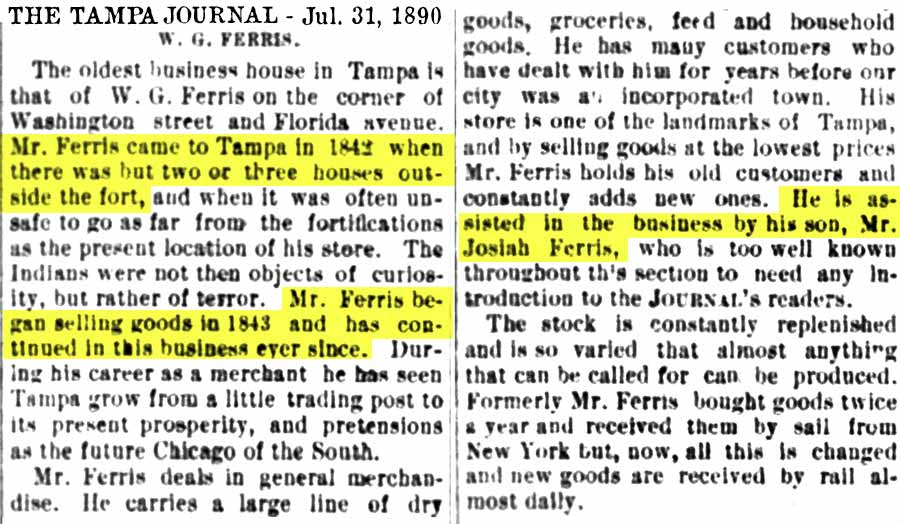
1850 CENSUS, FORT BROOKE,
POST OFFICE Tampa Bay
William G. Ferris (Sr.),
merchant (39, born New York)
and wife Eliza M. Ferris
(30, born Louisiana*),
children: Josiah (15) Clerk
b. Arkansas, Mary (13) b.
Arkansas,
William (6) b. Fla.,
Ann Eliza (4) b. Fla., Henry
C. (2) b. Fla.
*Eliza's birth place is also
listed as Louisiana on her
1860 census, but her 1870
and 1880 censuses show Ohio.
WGF-2 was their first
surviving child born in
Florida. Josiah was
working as a clerk in his
father's store.
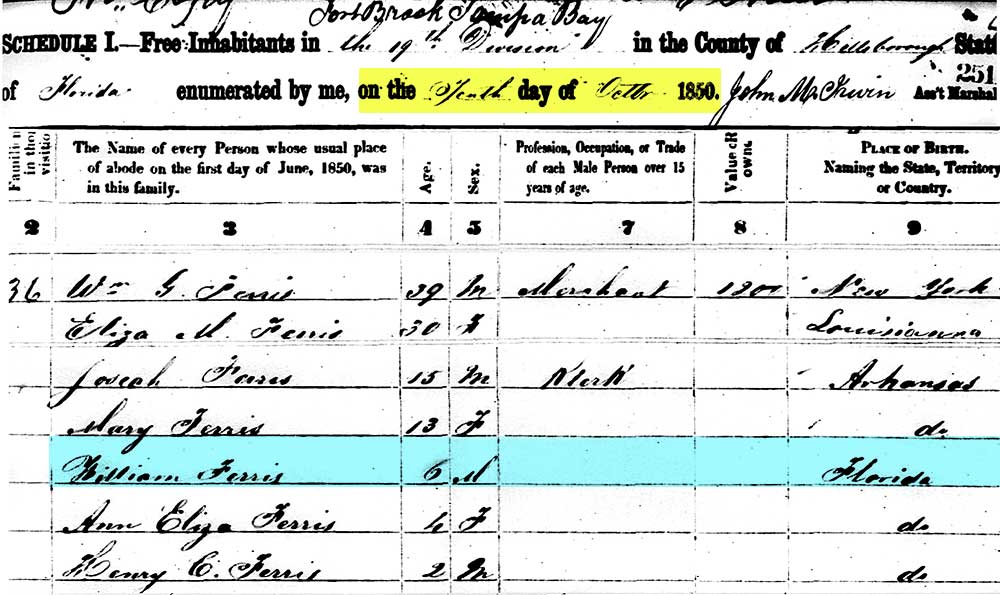
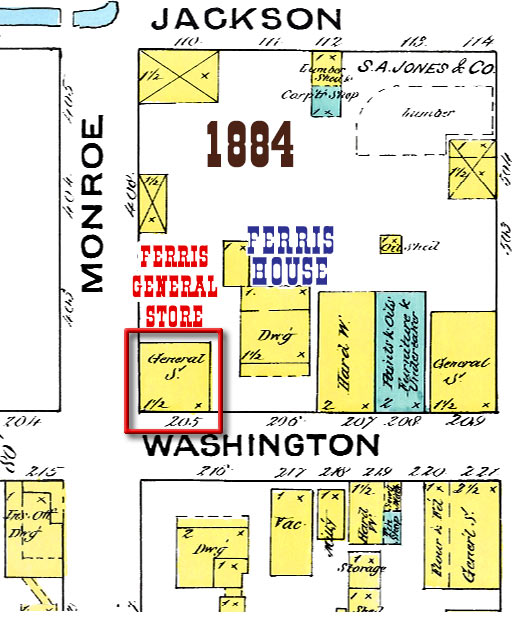
Also in 1857, Ferris
constructed a new two-story
home for his family on
Washington Street, just east
of the store. In addition to
being a prominent merchant,
he was a pioneer in the
shipping business and owned
a number of schooners and
steamers.

Perhaps the most famous of
the Ferris ships was the
steamer Scottish Chief.
The Florida Peninsular
newspaper reported on July
28, 1860 (portions below)
that W. G. Ferris and Son
had entered the cattle
business and had purchased a
small steamer, the Scottish
Chief, "a ship well
calculated for the cattle
industry." Later
during the Civil War, the
Scottish Chief was used as a
Navy blockade runner by
Capt. James McKay
and was eventually set afire
and sunk by Union forces in
the Hillsborough River in
October, 1863. (Also see "The
Life and Times of James T.
Magbee Page 2 -
1861 Secession to End of
Civil War. and James
McKay, Sixth Mayor of Tampa
all at TampaPix)
Sunland Tribune Vol. 22,
1996 "Tampa
Is The Place of Places"
by Kyle Vanlandingham, at
USF Library Digital Commons.
This 1884 Sanborn fire
insurance map from the
University of Florida
digital maps collection.
shows the house was 1˝
stories.
EXCERPTS FROM THE ARTICLE
DESCRIBED ABOVE
See the whole article.
When it opens, click it
again to see it full size.
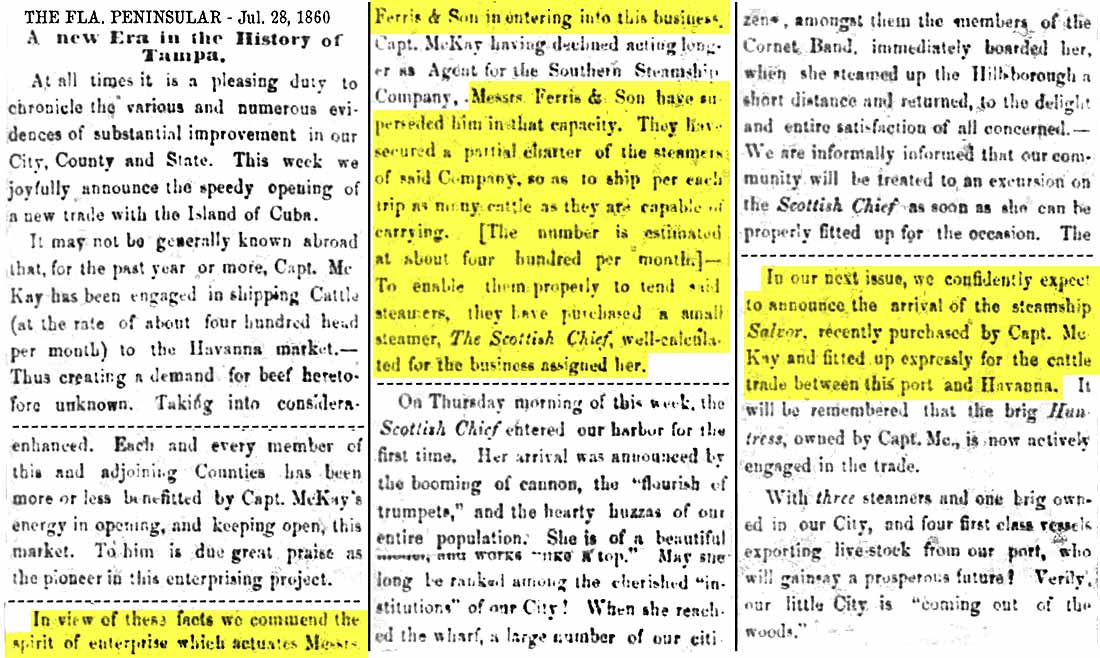
McKay also used the "Salvor"
for more than just shipping
cattle. During the
Civil War, he smuggled
supplies past the Naval
blockade into Tampa, where
he was hailed as a hero,
while just before the war he
was selling beef and
supplies to the Union troops
at Key West. On
Oct. 14, 1861, while
attempting to sneak through
the blockade with arms,
ammunition, whiskey & cigars
from Cuba, the U.S. Navy
captured McKay, his ship,
his young son, the crew, a
few passengers, and his
slaves.
Read about the capture of
the Salvor and McKay's
imprisonment, here at
TampaPix.
Monroe street was officially
renamed Florida Avenue at a
city council meeting on May
2, 1888, but references to
Florida Ave. can be found in
newspaper articles as early
as 1879. The context
of its use appears that it
refers to the road as it led
out of Tampa to the north,
beyond the city limits as
far north as Buffalo Ave.
(now MLKing Jr. Blvd.)

1860 CENSUS, TAMPA
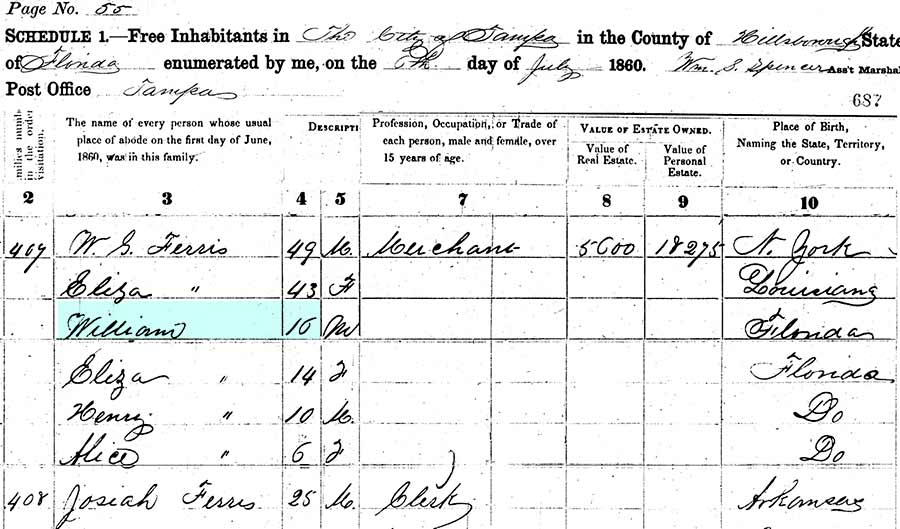
William G. Ferris, Merchant
(49, b. New York) and wife
Eliza Ferris (43, has aged
13 years since 1850, b.
Louisiana*), children: Mary
is no longer in the home.
Josiah has moved out and is
living next door.
William (16) , Eliza
(14), Henry C. has aged 8
years since the 1850 Census
(10) he should be 12 here,
Alice (6) was born after the
1850 Census.
*Her birth place in 1870 and
1880 censuses show Ohio.
William G. Ferris, Sr.
was a leader in many
ventures. He was a founder
and fifth largest
stockholder of the Florida
Peninsular Railroad Company
in 1859 and was president of
the Tampa Ice Company which
built an ice house on
Washington Street in 1860.
On Nov. 24, 1860, when
Hillsborough County citizens
convened in a mass meeting
at the Alafia to urge
secession of Florida from
the Union, W. G. Ferris was
among those present who
signed the petition calling
for a state convention to
consider the matter.
After the Civil War, the
Ferrises resumed their
shipping business and
continued to operate their
general store.
THREE SONS OF WILLIAM G.
FERRIS, SR. & ELIZA MORRIS
|
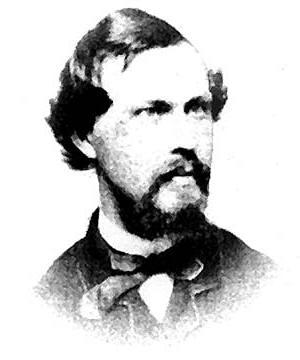
Josiah Ferris
1836 - 1901
Photo courtesy
of Sunland
Tribune Vol. 22,
1996 |
JOSIAH FERRIS - ELDEST
SON
Italics from
City of Tampa Mayors -
Josiah Ferris, 11th Tampa
Mayor
Born on August 5, 1836 in
Arkansas,* Josiah Ferris was
the eldest of six children
born to William Gould Ferris
Sr. and Eliza Morris Ferris.
Josiah , along with his
father, enlisted in the
Florida militia during the
Third Seminole War
(1855-1858). Prior to
the Civil War, Josiah had
become a business partner in
his father's general store
and cattle business.
The Ferris brothers, Josiah
and William, were members of
the Tampa Brass Cornet Band,
organized March 31, 1860, by
J. A. Butterfield. The
band’s musical instruments
were purchased for $170.11
from W. G. Ferris & Son.
On April 21, 1861 the 20th
Florida Regiment (CSA)
assumed command at the
abandoned Fort Brooke and
declared Tampa under Martial
Law. Mayor Snell
and other City officials
served without pay during
most of their term when all
City salaries were cancelled
after May 20, 1861.
|
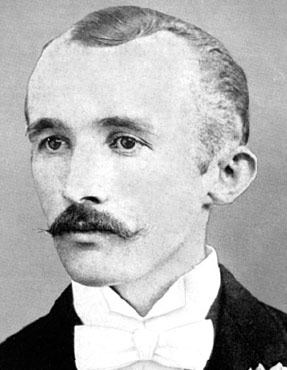
Josiah Ferris,
no date given.
From City of
Tampa Past
Mayors.
(TampaPix is not
convinceed this
is the same
person as seen
at left. Head
shape, eyes and
ears are too
different.) |
Snell resigned as Mayor and
hurriedly left Tampa after
selling his properties. One
possible explanation is that
he realized Tampa could not
be effectively defended
against Union invasion from
the sea and had no desire to
remain in the city.
Tampa's "S.S. Guards" were
the "Sunny South Guards", a
volunteer company commanded
by Capt. John T. Lesley
which became Co. K, 4th
Florida Infantry Regiment
CSA during the war.
Josiah served in the 4th
Florida Infantry Regiment.
After the war, Josiah
resumed
working
with his father in the
business. Josiah also
established a successful
jewelry business in Tampa.
 In
1862, Josiah Ferris married
Caroline Rhodes. They had
four children: John William,
Josiah, Jr., Rawson and
Allie. They were married for
eight years when, following
a brief illness, Caroline
Ferris passed away on
January 31, 1871.
Ferris then married Maggie
Knight, with whom he had two
children: Thomas Lee and
Ghira. In
1862, Josiah Ferris married
Caroline Rhodes. They had
four children: John William,
Josiah, Jr., Rawson and
Allie. They were married for
eight years when, following
a brief illness, Caroline
Ferris passed away on
January 31, 1871.
Ferris then married Maggie
Knight, with whom he had two
children: Thomas Lee and
Ghira.
Some former residents of
Tampa returned after the war
and the citizenry tried to
rebuild the town. Efforts
were made to re-establish
the town's government,
however, it took over a year
before the citizens of Tampa
were permitted to hold
municipal elections and
other aspects of city
government.
On October 25, 1866, Edward
A. Clarke was elected mayor
of Tampa.
Ferris became involved in
local politics following the
Civil War and served as the
president of Tampa's city
council.
Other council members
included Dr. William A.
Liveley, Robert Flournoy
Nunez and Bartholomew C.
Leonardi.
After Mayor E. A.
Clarke's quiet departure in
December of 1866., Josiah
Ferris served as Acting
Mayor until John T. Lesley
was elected as mayor.
Lesley had previously
served as Sheriff from 1866
to 1869. Leslie campaigned
on a single platform that
Tampa's charter should be
revoked by the state
legislature due to the
City's destitute financial
condition. The majority of
residents agreed and Lesley
was elected mayor on March
1, 1869. Josiah Ferris
was the first Tampa native
to serve as mayor of Tampa,
but since he was not an
elected mayor, he usually is
not considered to be the
first. (That credit goes to
Thomas Edward Jackson, son
of Tampa surveyor and
pioneer merchant John
Jackson. Thomas was born in
Tampa in 1852 and was the
15th (1877) and 24th (1889)
mayor of Tampa.)
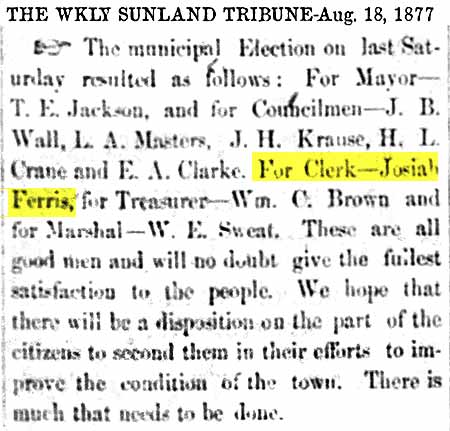 While
under Lesley, a City Clerk,
Treasurer (Josiah Ferris)
and a City Council was
elected; the Lesley
Administration did little
more than wait until the
state legislature revoked
Tampa's Charter due to an
inactive government. On
October 4, 1869, the state
legislature responded as
expected and revoked the
City's charter. When the
news reached Tampa, Lesley
and other City officials
resigned their positions.
The Hillsborough County
government appropriated all
City properties and assumed
responsibility for providing
educational and other
principal services to
Tampa's residents. Tampa's
status as a non-chartered
city continued until August
1873 when residents voted to
reincorporate as a town. While
under Lesley, a City Clerk,
Treasurer (Josiah Ferris)
and a City Council was
elected; the Lesley
Administration did little
more than wait until the
state legislature revoked
Tampa's Charter due to an
inactive government. On
October 4, 1869, the state
legislature responded as
expected and revoked the
City's charter. When the
news reached Tampa, Lesley
and other City officials
resigned their positions.
The Hillsborough County
government appropriated all
City properties and assumed
responsibility for providing
educational and other
principal services to
Tampa's residents. Tampa's
status as a non-chartered
city continued until August
1873 when residents voted to
reincorporate as a town.
Josiah Ferris and his
father were two of the
founders of St. Andrew’s
Church in 1871.
Ferris returned to his
business ventures and after
his second term as a city
council member, he
campaigned for City Clerk in
Aug. 1877 and won. He
remained in that position
for nine years from
1877-1886 . Josiah Ferris
died on November 24, 1901 in
Tampa.
|
Josiah's obituary is
incorrect about his birth
place.
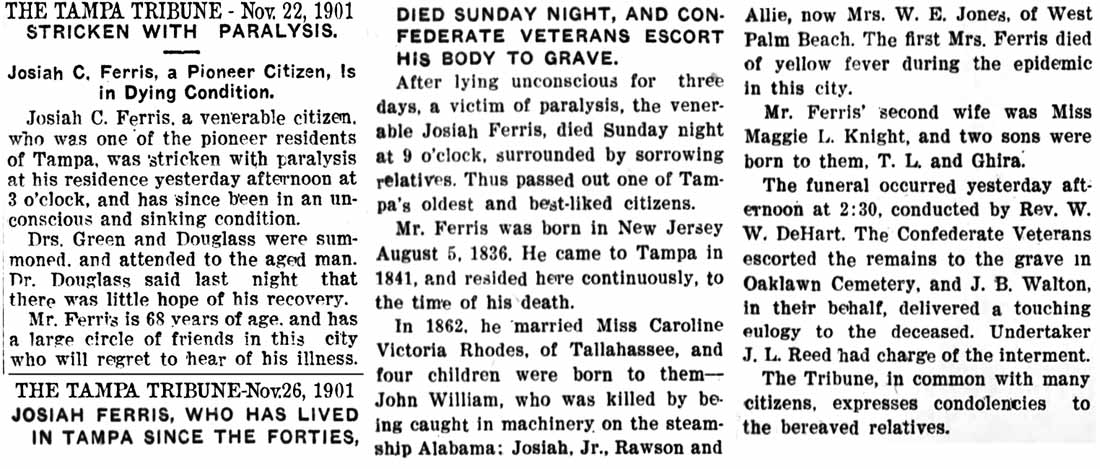
*TampaPix
note: His Tampa
Tribune obit claims he was
born in New Jersey.
This is wrong. His father
had died, his mother had
died, he was the oldest
child, nobody was left who
knew where he was born.
Earliest OFFICIAL records
are the most accurate, and
ALL his censuses show
Arkansas. His
parents MET in Arkansas and
MARRIED there in 1834.
Two years after Josiah was
born, his sister Mary was
born in Arkansas.
**The
City of Tampa has removed
this publication from their
website, maybe because of
its erroneous information
concerning the history of
old City Hall and the naming
of Hortense, the clock,
BUT you can still read it
and download it from
TampaPix's Dropbox folder.
Josiah Ferris' signature in
1865 on the Florida Oath of
Allegiance to the Union at
Tallahassee, Fla.
Florida's Oath of Allegiance
to the Union
(The date has been
reproduced here from a line
near the top of the page due
to ditto marks.)

|
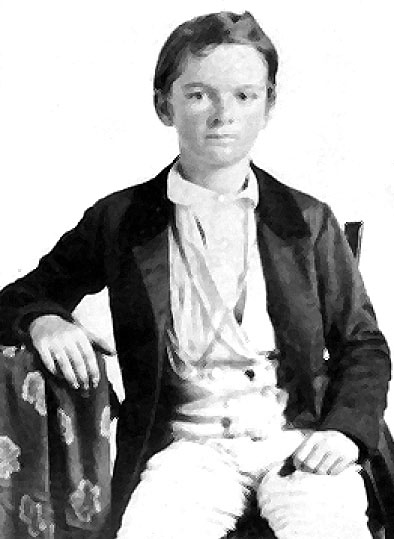
William G.
Ferris, Jr.
1844 - 1867
Photo courtesy
of Sunland
Tribune Vol. 22,
1996 |
WILLIAM GOULD FERRIS, Jr.
(WGF-2)
2ND SON of WGF-1 & ELIZA
MORRIS
William G. Ferris, Jr.
was born July 29, 1844 in
Tampa. He married
FLORENCE HUNTER
on May 25, 1865 in Leon
County, (Tallahassee)
Florida. [No license image
available.] According to her
1870 Census, Florence was
born 1844 to 1845 in
Florida.
Florence appears on various
later records under
different first and middle
names (Susan and Florence.)
Sometimes an initial "A." is
used. Online
researchers of this family
claim the "A" stood for
"Andrew," her father's name.
Combined, she was Florence
Susan A. Hunter, a daughter
of Andrew J. Hunter
and Mary Houston.
TampaPix has been unable to
find Andrew and Mary Hunter
on a Florida census.
However, there is a marriage
record of Andrew & Mary from
Leon County marriage books.
|
|
MARRIAGE OF FLORENCE'S
PARENTS - ANDREW J. HUNTER
and MARY HOUSTON
Florence's parents married
in Leon Co., Tallahassee on
Jan. 25, 1844. Florida
had not yet become a state
and was still a U.S.
Territory. Their
daughter (Susan) Florence
Hunter was born in 1844 to
1845.

They applied for their
license on Jan. 18.
See their license.
|
|
REMARRIAGE OF MARY HOUSTON
HUNTER
TampaPix has been unable to
find what happened to
Florence's father, Andrew
Hunter, but on Feb. 20,
1854, Florence's mother,
Mary Hunter, married
Samuel Humphress at
Monticello, Jefferson Co,
Fla.
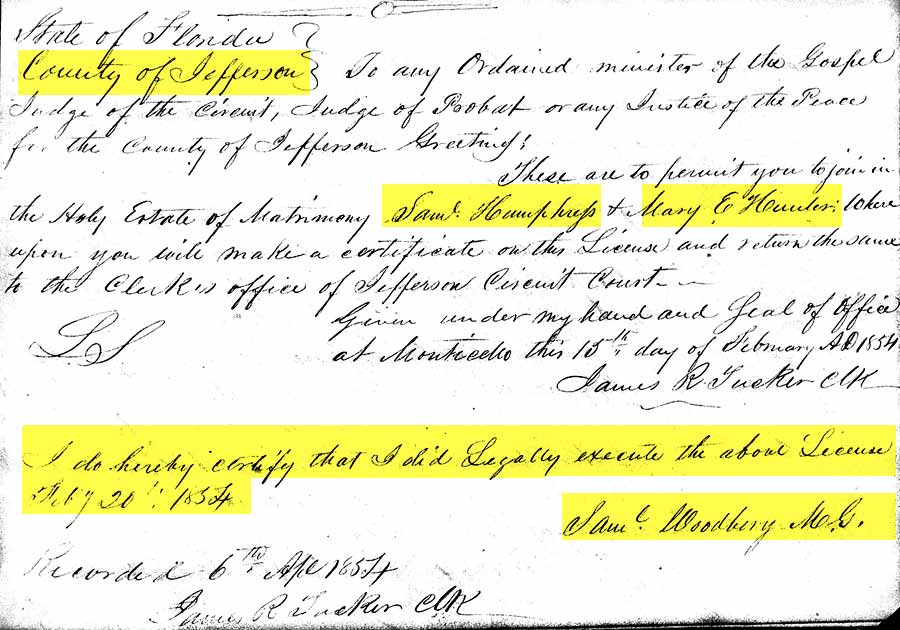
Click the image to see it
larger.
1860 CENSUS, WAKULLA CO.,
FLA.
Six years and four months
later, 15 year old Florence
Hunter, and her mother and
stepfather, appear on the
1860 Census of Wakulla
County, "Between
Sopshapey (Sopchoppy)
and St Marks Rivers,"
Newport Post office.
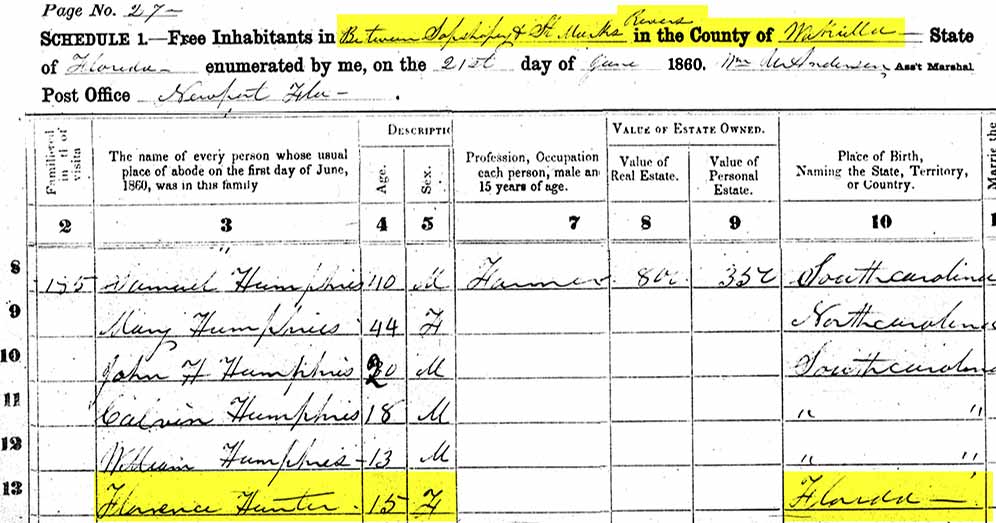

Although the census record
shows "Humphries," his
tombstone, which appears to
be the original, (photo
courtesy of Find A Grave)
shows "Humphress" like his
marriage license.
Florence was listed last and
out of order of descending
age in the family of Samuel
(40, born in SC) and Mary
(44, born in NC). They are
followed by what appears to
be Samuel's three sons from
a prior marriage, as they
were born before 1854.
John (20, b. c1839-40),
Calvin (18, b. c1841-42),
William (13, b. c.1846-47).
Listed last is Florence
Hunter (15, b. c. 1844-45.)
This indicates that she was
not a child of the head of
house. This census did
NOT record relationships,
but the rule with all
censuses was that children
of the head of house are
always listed first in
descending order of age,
then non-children of the
head of house are listed
from oldest to youngest.
|
|
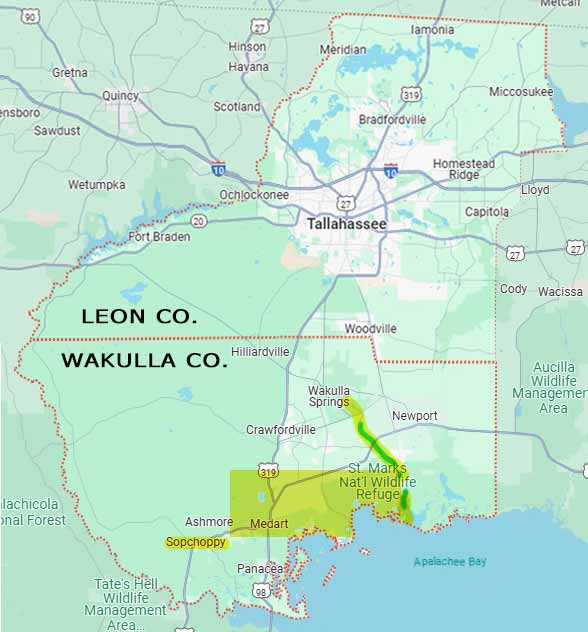
HOW DID FLORENCE HUNTER MEET
WM. G. FERRIS JR.?
The proximity of Wakulla Co.
to Leon Co. no doubt played
a role in the reason why
Florence and Wm. G. Ferris,
Jr. met and married in Leon
County in 1865.
Wakulla County is located
just south of Leon County,
where Florida's State
Capital of Tallahassee is
located. Wakulla Co.
borders the northern coast
of the Gulf of Mexico.
Recall Josiah Ferris was in
Tallahassee in 1865 to sign
the Florida Oath of
Allegiance after the Civil
War. WGF-1
may have gone up there with
him and the quickest way
would have been by steam
ship from Tampa into
Apalachee Bay, to a port on
the St. Marks River.
They may have met at the
port or even in Tallahassee.
Or, the brothers may have
been on their way back home
when the war ended.
Their only child,
William Houston Ferris
(WHF)
was born in Jan. 1867 in
Tampa, Fla.
He was the husband of
Katherine Craig.
|
|
William G. Ferris, Jr.,
died two days before his
23rd birthday, on July 27,
1867.
As his obituary
states, he was so well-known
in Tampa that "a more
extended [obituary] was
entirely unnecessary here at
home where he was born..."
He died of "dropsy of the
chest."
West Chester University
Digital Commons Dropsy
(Dropsey/ Dropsy in the Leg/
Dropsy of the Brain) - An
unnatural accumulation of
serous fluid in any serous
cavity of the body, or in
the subcutaneous cellular
tissue. The various forms of
dropsy affecting different
parts of the body are
designated by specific
names. Heart Failure /
Heart Failure and
Dropsy/Heart failure.
|
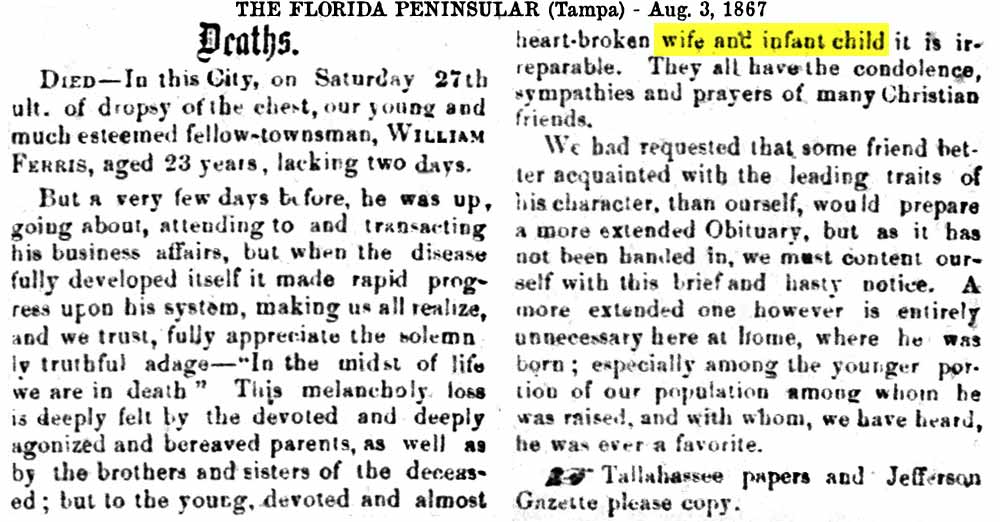 |
|
The Graveyard of old
diseases: Dropsy,
swelling caused by a fluid
buildup, is a symptom of
kidney disease or congestive
heart failure and can affect
the lower exterminates,
abdomen, or chest cavity.
According to
mid-nineteenth-century
author Horatio Goodday, over
half of deaths from dropsy
could be prevented with
“good air; suitable
clothing, and shelter
against excess of damp,
cold, and heat; cleanliness,
proper food; exercise; rest;
and the right observance of
the Sabbath.” Cases of
dropsy were often deadly and
physicians recommended
drawing out the fluid to
relieve the patient’s
suffering and prolong life.
Thought.com Historic Causes
of Death Dropsy -
Edema; often caused by
congestive heart failure. |
Wiliam G. Ferris, Jr. was
buried in Tampa's first
cemetery, Oaklawn.
Gravesite photos courtesy of
Find A Grave.
HENRY CLARKE FERRIS -
17th MAYOR OF TAMPA,
NO PHOTO AVAILABLE
The youngest son of
WGF-1 and Elizabeth
Morris, Henry Clarke
Ferris was born in Tampa
on May 21, 1848.
He was the second
native of Tampa to
become its mayor.
Term: August 14, 1880 -
February 19, 1881.
His middle name was in
honor of Edward A.
Clarke, also a pioneer
Tampa merchant and Tampa
mayor. Growing up,
Henry Clarke Ferris
worked in his father's
general store and after
his father passed away,
he took over managing
the store. Interested in
politics, Ferris
successfully campaigned
for mayor in August of
1880. At the time of his
election, Tampa had only
about seven hundred
residents. Yellow fever
was rampant and Tampa
still lacked a railroad.
Mayor Ferris only served
for six months because
during his term, he
moved across the river,
outside of the town
limits. Because of that,
he had to resign, and
Matthew E. Haynesworth,
who was President of the
City Council at the
time, stepped in as
Acting Mayor. Ferris ran
again for mayor in 1887,
but was defeated by
George B. Sparkman,
Tampa's first mayor of
its second
incorporation. Henry
Clarke Ferris continued
to work as a merchant
after leaving office. He
was married to Julia
Bartholomew, and they
had a daughter named
Della. He died in Tampa
on September 27, 1902.
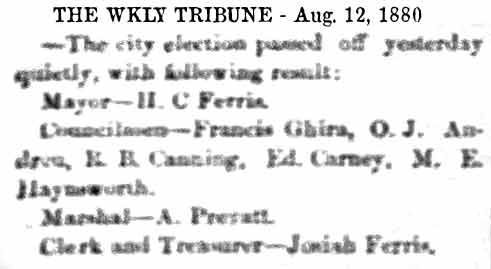
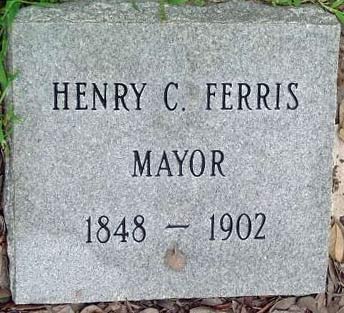
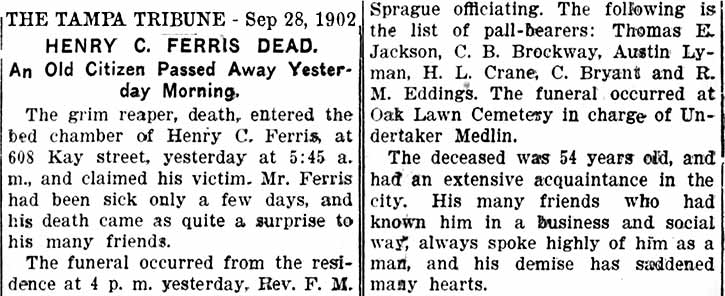
|
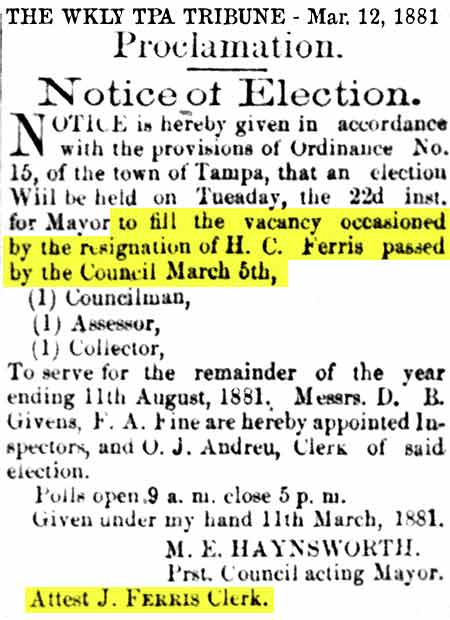
HENRY C. FERRIS OBITUARY
"Old citizen passed away
this morning." He was
54.
No mention of having been
mayor of Tampa, no mention
of occupation, no mention of
surviving family.
|
|
WILLIAM HOUSTON FERRIS (WHF)
- SON OF
WILLIAM G. FERRIS, JR.
AND FLORENCE HUNTER FERRIS
Three years after the
death of her husband,
Florence Ferris and three
year old William H. Ferris
are on page 140 of the 1870
Census. "Inhabitants
in" is blank because Tampa
as an incorporated area no
longer existed, its charter
having been dissolved.
Others listed in the
vicinity are mostly farm
laborers, and the presence
of William Ashley and
Constance Bourquardez nearby
indicate this is probably an
area in the "north" of Tampa
which is now the area around
Oaklawn Cemetery from
Harrison St. to Interstate
275. The value of her
real estate, $1,500,
indicates a larger plot of
land than most others in the
area, and her personal
property, $500, indicates
she was no poor widow.
Living in her home were a 30
year old black cook named
"Rachel Ferris" and black
house servant named Charles
H. Hendry. Also in the
home were a black sailor
named Frank Seward (20) and
Sylvey Seward (11) a
nurse(at age 11?).
It's possible Florence was
being supported by her
father-in-law WGF-1 or an
inheritance as her
occupation is "keeping
house."
WHF was 3 years old
and if recorded correctly,
this was his age on June 1,
1870, the official census
date. Even though the
enumerator visited on July
15, 1870. it means he
was born sometime from June
2, 1866 to June 1, 1867,
because all ages were to be
recorded as their age was on
their last birthday on or
before June 1, 1870.
1870 CENSUS, TAMPA
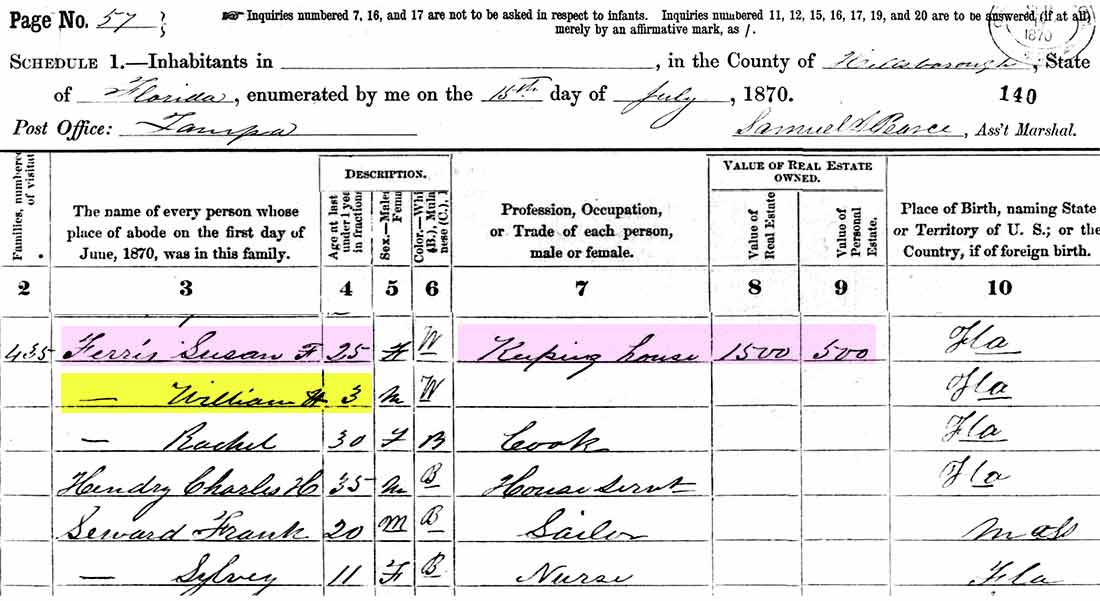
TAMPA AND FT. BROOKE AFTER
THE CIVIL WAR
After military units were
transferred from Fort Brooke
in 1858, it was leased to
Captain James McKay but his
use was interrupted first by
Confederate and then Union
troops. When the fort was
occupied by the
Confederates, the place was
bombarded several times by
Union warships. At the
conclusion of the conflict,
Union troops occupied the
post as a base of operations
for the military occupation
of the area until 1869.
As Tampa languished during
the 1870s and early 1880s,
so did Fort Brooke. When the
occupying troops left Fort
Brooke during Reconstruction
days, some of the land was
declared part of the public
domain and squatters moved
in. When yellow fever became
a grave problem for the
artillerymen stationed at
Key West, military
authorities searched for a
nearby place where most of
the men could be moved
during the so-called "sickly
season."
FLORENCE HUNTER FERRIS
MARRIES CHARLES HANFORD
Three years after the death
of her young husband, and
less than two months after
the 1870 Census, Florence
married Irishman Charles
Hanford on Sept. 1, 1870
in Tampa.
Marriage record of Mrs.
Florence Ferris and Charles
Hanford.
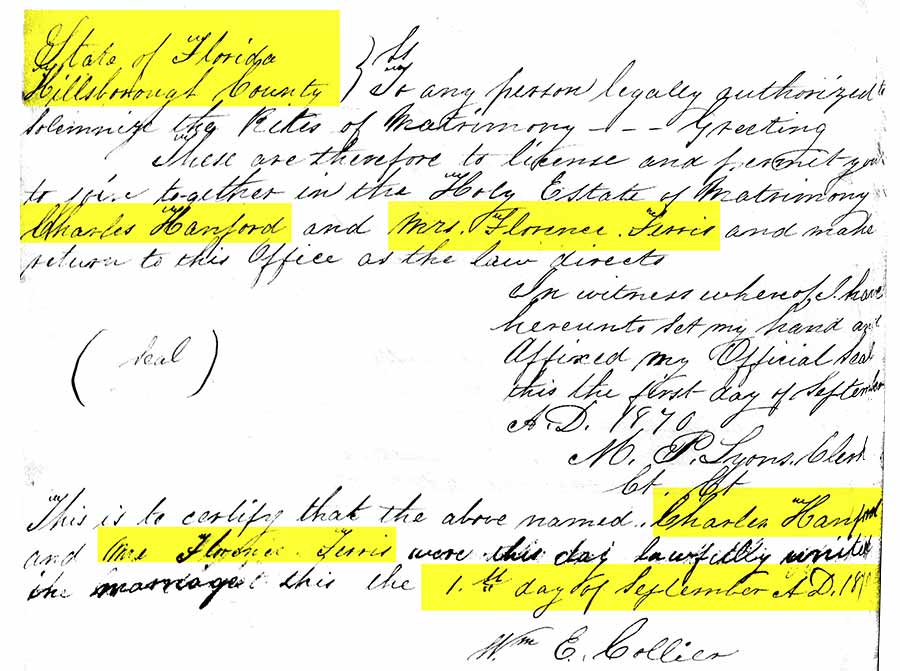
CHARLES HANFORD ON THE
1870 CENSUS
Charles Hanford was born
c1845 in Ireland according
to his 1870 Census which was
taken bout two months before
his marriage to Florence
Ferris. His occupation
was "QM
USA" (Quartermaster).
Hanford was living next to
Spanish Tampa pioneer Joseph
Robles and Joseph P. Robles
(his son.) On the previous
page was Judge Perry G.
Wall, merchant John Darling,
cattleman & merchant John T.
Lesley, steamer captain
James McKay Jr., merchant
James McKay Sr., stock
raiser William (B)
Henderson, sailor Josiah
Ferris (Jr), and merchant
Christopher Friebele.
On the next few pages
were merchant John Jackson,
Dr. Franklin Branch,
merchant Edward A. Clarke,
and William G. Ferris, Sr.,
These were all early Tampa
pioneers who had businesses
and homes in the heart of
Tampa on or near Franklin
Street at Jackson St.,
Washington St. and Whiting
St.
Recall Florence Ferris was
living with her son six
pages away from Hanford, on
page 140, in the northern
part of town near what is
now Tampa Heights.
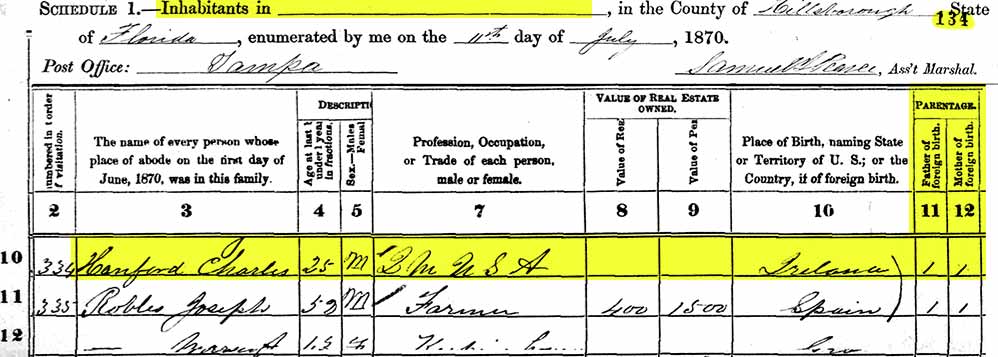
"Inhabitants in" is blank
because there was no Tampa
city limits, town or
village. The charter
had been dissolved.
According to a Sept. 23,
1871 Fla. Peninsular article
which mentions him, Mr.
Hanford was the
Quartermaster's Agent for
Fort Brooke at the time.
The article is in poor
condition and beyond
enhancement to be presented
here, so here is a
transcription. it is a
letter to the Peninsular by
an unnamed writer.
|
THE PENINSULAR,
Saturday, Sept.
23d, 1871 - H.
L. Mitchell,
Editor.
The Late
Sheriff and Tax
Collector of
Hillsborough
County.
MR. EDITOR--The
circumstances
attending the
death and burial
of the late Wm.
McFarland, a
prominent member
of the
Republican
party, and a
gentleman held
in high esteem
for his many
virtues and
amiable
qualities,
having given
rise to some
comment "it is
well perhaps
that an
authentic
account should
be furnished the
readers of the
PENINSULAR in
order that the
personal and
political
friends of the
deceased may
know, and draw
their own
references."
Col. McFarland was seized with the prevailing fever one week
ago while on a
visit to his
friend, Dr.
Hamlin at
Sulphur Spring,
and
notwithstanding
the most
skillful
treatment and
careful nursing
on the part of
Dr. and Mrs. H,
sunk until
Thursday morning
at five o'clock
when he expired.
Notice was
promptly sent to
his friends in
town, and every
one naturally
expected that
nothing would be
spared on their
part to show
every respect to
his remains.
The necessity of
using every
expedition in
the matter was
evident; but
notwithstanding
this, it was
found that
preparations
were only begun.
Imagining
somewhat the
feelings of Dr.
Hamilin and
family under
such
circumstances,
MR. CHARLES
HANFORD, Quarter
Master's Agent
at Fort Brooke,
accompanied
by the Rev. R.
A. Simpson of
the Episcopal
Church,
drove out to Dr.
Hamlin's
residence, there
arriving at ===
(damage to page)
they found Dr.
Hamlin ill and
in bed, and the
remains of the
lamented Col.
McFarland in
status quo
as for the
previous
fourteen hours.
This may be
better imagined
than described.
Two hours more
elapsed, and
neither friends
nor coffin
arriving, the
imperative
necessity of
immediate Burial
was but too
apparent.
The suggestion
was made that
the lateness of
the hour
precluded the
possibility of
removal and
subsequent
interment in the
cemetery near
town and
consequently a
grave had better
be prepared near
the spot.
At 10 P.M.,
assisted by Mr
Henry Murphy, a
neighbor of Dr.
Hamlin, this
arduous task was
commenced, and
at 11 no coffin
being
forthcoming,
Messrs. Hanford,
Simpson and
Murphy, carried
the shrouded
remains of an
honest man and
good citizen to
their last
resting place,
some two hundred
yards north west
of the Doctor's
residence.
Here, literally
"no useless
coffin enclosing
his breast," he
was committed to
Mother Earth,
the solemn words
of the Church's
last ritual for
the dead being
recited by the
Rev. Mr.
Simpson, as the
fading radiance
of the fair
Southern moon
dimly beamed
from the
horizon.
These are the
facts, gentle
reader, and
truly "facts are
stubborn
things."
"Alas for the
varity
Of Christian
charity,
Under sun."
|
|
CHARLES HANFORD
AND FORT BROOKE
HISTORY
(See "Final
Battle for Ft.
Brooke" at
TampaPix.com for
sources.)
In 1864,
Northern forces
destroyed all of
the main
buildings inside
Fort Brooke and
destroyed a salt
processing
factory owned by
Confederate
blockade-runner
and former Tampa
Mayor James
McKay. Union
forces occupied
the fort from
1864 until 1869.
According to
The Final Years
of Fort Brooke"
by James
Covington,
Sunland Tribune,
Charles Hanford
was one of the
commanders at
Fort Brooke at
this time.
From 1869, the
fort fell into
disrepair. By
1873, the
buildings in the
Fort Brooke
federal
reservation were
unoccupied and
James McKay was
given a lease to
use the wharf
and one-half of
the warehouse
for his cattle
shipping
operations.
Captain McKay at
this time had
the largest
fleet of
schooners and
steamers in the
state of
Florida.
Charles Hanford married
Florence (Hunter) Ferris on
Sep. 1, 1870 in Tampa.
Her son William H. Ferris
was about 3˝ years old.
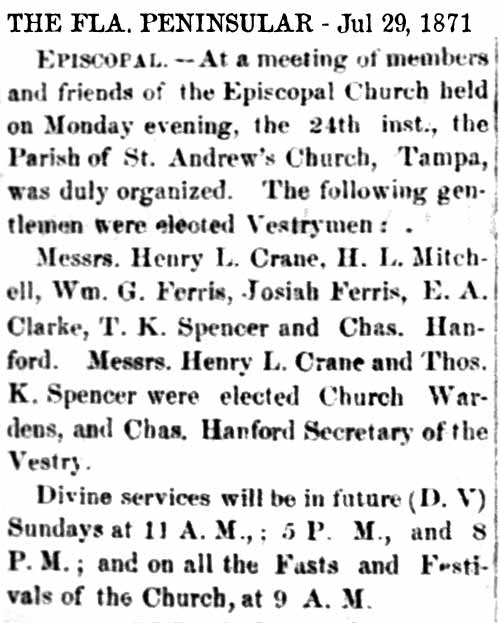 In
1871, Charles Hanford was
one of the founding members
of St. Andrews Episcopal
church. According to
an article in the Florida
Peninsular, a organizational
meeting was held on July 24,
1871. The
following gentlemen were
elected Vestrymen:
Henry L. Crane (son of H. A.
Crane, future owner of the
Orange Grove Hotel, County
Judge, Justice of the Peace,
U.S. Deputy Court Clerk,
late 1870s - 1890s, U.S.
Commissioner 1879-1920), H.
L. (Henry Laurens) Mitchell
(current editor of the
Peninsular late 1860s to
1870s, lawyer, Fla House of
Rep, future Supreme Ct.
Justice, future 16th Gov. of
Fla), Wm. G. Ferris
(Sr.), Josiah Ferris,
E. A (Edward A.) Clarke
(dry goods merchant and
former 10th Tampa mayor
1866, T. K. (Thomas) Spencer
(merchant and former editor
and owner of the Peninsular
late 1860s, future editor
Sunland Tribune) and Charles
Hanford." Crane and
Spencer were elected Church
Wardens and Hanford
Secretary of the Vestry.
(From
St. Andrew's Episcopal
church history.)
See Tampa Newspaper History
at TampaPix In
1871, Charles Hanford was
one of the founding members
of St. Andrews Episcopal
church. According to
an article in the Florida
Peninsular, a organizational
meeting was held on July 24,
1871. The
following gentlemen were
elected Vestrymen:
Henry L. Crane (son of H. A.
Crane, future owner of the
Orange Grove Hotel, County
Judge, Justice of the Peace,
U.S. Deputy Court Clerk,
late 1870s - 1890s, U.S.
Commissioner 1879-1920), H.
L. (Henry Laurens) Mitchell
(current editor of the
Peninsular late 1860s to
1870s, lawyer, Fla House of
Rep, future Supreme Ct.
Justice, future 16th Gov. of
Fla), Wm. G. Ferris
(Sr.), Josiah Ferris,
E. A (Edward A.) Clarke
(dry goods merchant and
former 10th Tampa mayor
1866, T. K. (Thomas) Spencer
(merchant and former editor
and owner of the Peninsular
late 1860s, future editor
Sunland Tribune) and Charles
Hanford." Crane and
Spencer were elected Church
Wardens and Hanford
Secretary of the Vestry.
(From
St. Andrew's Episcopal
church history.)
See Tampa Newspaper History
at TampaPix
Charles Hanford was
appointed Tampa's Postmaster
from Oct. 21, 1872 to Dec.
9, 1872. This was the
shortest term of postmaster
service through 1906.
See a 1909 Tribune article
of the history of Tampa's
post office and its
postmasters.
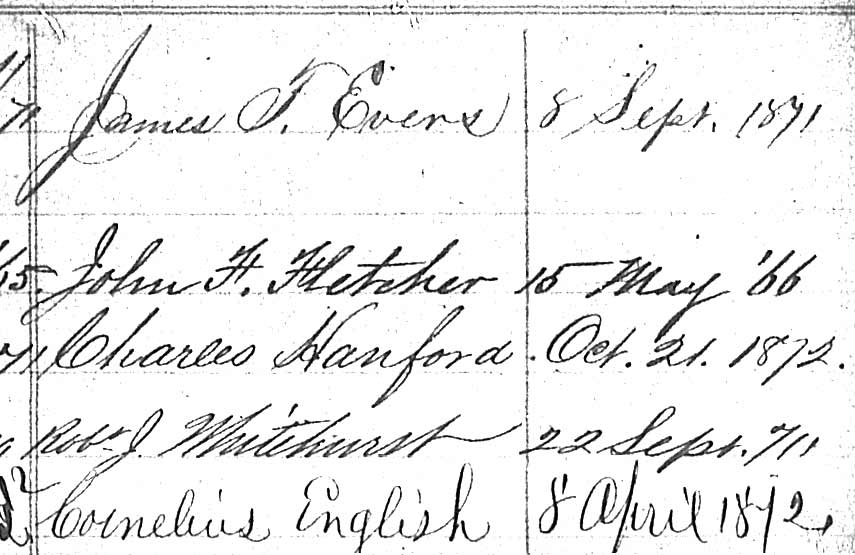
Image from
National Archives
"Postmaster Appointments for
Hillsborough County,
Florida, p.2
Hanford served as the
appointed
Hillsborough County clerk
from Sept. 1872 to March
1873. According to Karl
Grismer's "A History of
the City of Tampa and the
Tampa Bay Region of
Florida," by mid-summer
of 1873 economic conditions
had improved to such an
extent that the citizens of
Tampa decided that a
municipal government should
be re-established. So a
meeting was held August 11
and the 48 electors who
attended voted to
incorporate, this time as a
town instead of as a city.
James E. Lipscomb was
elected mayor, Charles
Hanford, clerk, and John
G. Robles, marshal.
Councilmen elected were W.
T. Haskins, E. A. Clarke,
John T. Lesley, Josiah
Ferris and Henry L.
Crane.
Hanford served as Tampa's
City Clerk for seven months
from Aug. 11, 1873 to March
11, 1874.
FORT BROOKE INSPECTED
The Final Years of Fort
Brooke" James Covington,
Sunland Tribune, 1981
University of S. Florida
Digital Commons.)
One who became
concerned about the
condition of the area in
1874 was Charles Hanford who
commanded the Union troops
at the fort when they
occupied the place.
He noted the grass and
weed-ridden cemetery,
"No longer is it a fit
resting place for soldiers."
Charles Hanford to Major
General Emery, October 20,
1874,"
The cemetery, one-fourth of
an acre square was located
one-fourth of a mile from
the reduced military
reservation.
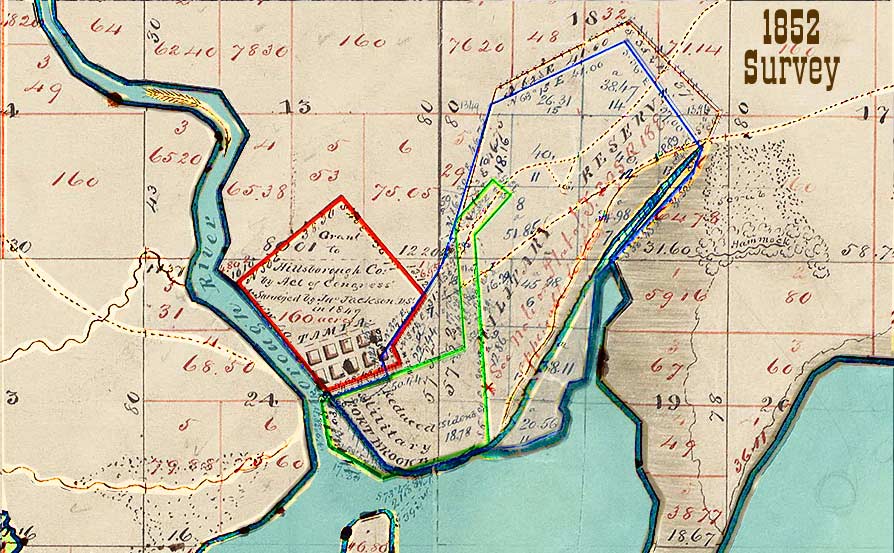
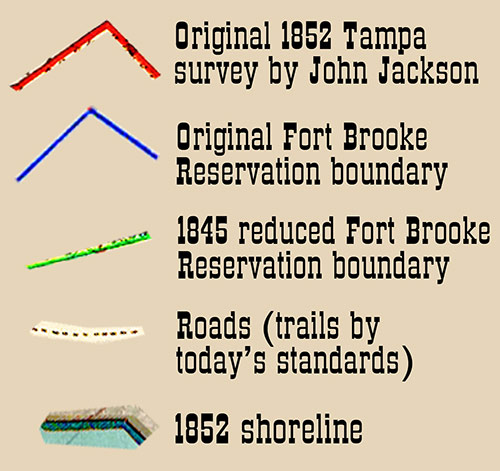
In response to Charles
Hanford's letter to the Army
command, $200 was spent
by the Quartermaster Corps
to improve the conditions.
In an inventory of the
standing buildings made
during the 1870s, the
following valuation was
made: Officer’s quarters,
85 x 46, $3,000;
barracks, 110 x 50, $1500;
hospital, 42 x 30, $500;
mess hall, 50 x 25, $500;
bake house, 50 x 25, $300;
storehouse, $50; commissary,
$100; flag staff, $500; four
wooden cisterns, $480 and
boardwalk, $50, making a
grand total of $7,180.40.
This letter to Gen. Emery
is the last known official
record of Charles Hanford in
Tampa, but there is one more
mention for 1885, the
validity of which is
unverified by TampaPix.
(See section below on
Florence Hanford on the 1880
Census). Mentions
of a Charles Hanford in
northern newspapers BEFORE
1870 and AFTER 1874 are
numerous, but there's no way
to tie him to Tampa's
Charles Hanford, as there is
no mention of age or native
country of Ireland or
military involvement.
The Oct. 6, 1862 Brooklyn
Daily Times published an
article "The 90th
Regiment at Key West"
stating "The New Era, dates
Sept. 27, published at Key
West, Fla. has been
received. It contains
only one additional death
from yellow fever--that of
CHARLES HANFORD, Co. E...."
Further research reveals
that this was Charles N.
Hanford who, like Tampa's
Charles Hanford, was born in
1844-45 but in New York and
was the son of New York
natives William H. and
Charlotte M. Hanford, and
grandson of Ozias & Mary
Hanford. These
families lived in the town
of Umadilla, Otsego County,
NY where William H. Hanford
was a shoemaker.
Charles N. Hanford was
buried at Barrancas
Cemetery, Pensacola, where
many U.S. Civil War dead
were transferred from Key
West and Fort Brooke
cemeteries.
In 1877 the size of the Ft.
Brooke government
reservation land was
reduced. The military
authorities regained control
of Fort Brooke when the
President of the United
States set aside 155 acres
in January 22, 1878 and May
29, 1878, for military
purposes with the remaining
land kept in the public
domain, which became known
as the town of Fort Brooke.
In 1880 Captain Jacob Rawles
of the Fifth Artillery made
a thorough inspection of the
155 acres with its rundown
buildings, Indian mound,
scattered live oak and
orange trees, dock,
cemetery, springs, winding
creek and thick woods to the
east of the buildings. In
his report dated September,
1880, Rawles noted that
there were no storehouses at
all on the site.
Quarter-master supplies for
the troops from Key West
were either placed under
tents or in an old log
stable and food stored in an
old guard house building.
Officers’ quarters
likewise in poor condition,
consisted of one building
containing a hall and four
rooms on the first floor,
and four attic rooms on the
second. (This is
the building seen in the
classic old photos of "The
Officer's Quarters" showing
a long porch with rocking
chairs.) Two kitchens
to prepare food for the
officers were located twenty
feet from the building, but
under a common roof that
needed shingles. Only one
large wooden building served
as housing for the
artillerymen from Key West.
The doors and windows had
been stolen and the sills
under them were in a rotten
state. New floors and a roof
were needed. The hospital
consisted of a small wooden
building which contained a
dispensary, beds for twelve
patients and erected nearby
was the kitchen.
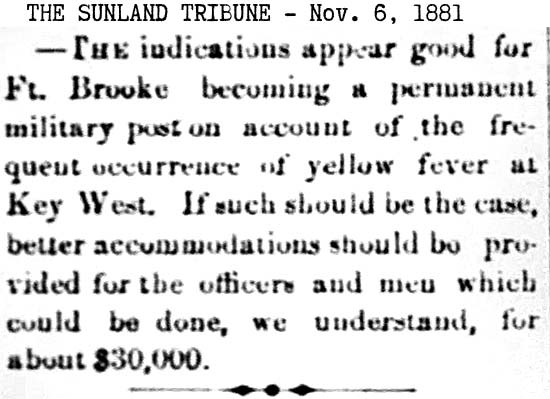 During
the winters of 1878-79, and
1879-80, the Key West
garrison was moved to Fort
Brooke where it remained
until traces of Yellow Fever
had disappeared from Key
West. Believing that the
seasonal move from Key West
to Tampa would become an
annual event, the quarters
at Fort Brooke were given a
thorough evaluation by
military authorities. During
the time that the post had
been deserted, people of
Tampa had roamed through the
deserted post removing
windows and doors, and
carrying away boards and
bricks for use in their
homes. Such removals were
commonplace. Insult was
added to injury at Fort
Brooke when citizens
deposited their "night soil"
on the grounds. Years later,
the town of Fort Brooke
would be a filthy,
disgusting area with its own
mayor, law enforcement, and
town government. The
town of Ft. Brooke remained
a separate municipality
until it was annexed into
Tampa in 1907. During
the winters of 1878-79, and
1879-80, the Key West
garrison was moved to Fort
Brooke where it remained
until traces of Yellow Fever
had disappeared from Key
West. Believing that the
seasonal move from Key West
to Tampa would become an
annual event, the quarters
at Fort Brooke were given a
thorough evaluation by
military authorities. During
the time that the post had
been deserted, people of
Tampa had roamed through the
deserted post removing
windows and doors, and
carrying away boards and
bricks for use in their
homes. Such removals were
commonplace. Insult was
added to injury at Fort
Brooke when citizens
deposited their "night soil"
on the grounds. Years later,
the town of Fort Brooke
would be a filthy,
disgusting area with its own
mayor, law enforcement, and
town government. The
town of Ft. Brooke remained
a separate municipality
until it was annexed into
Tampa in 1907.
Soldiers standing at
attention in camp at Fort
Brooke. This is very likely
to be the Key West Troops
who were stationed there
from May 1880 to 1882, after
which time the fort was
decommissioned.
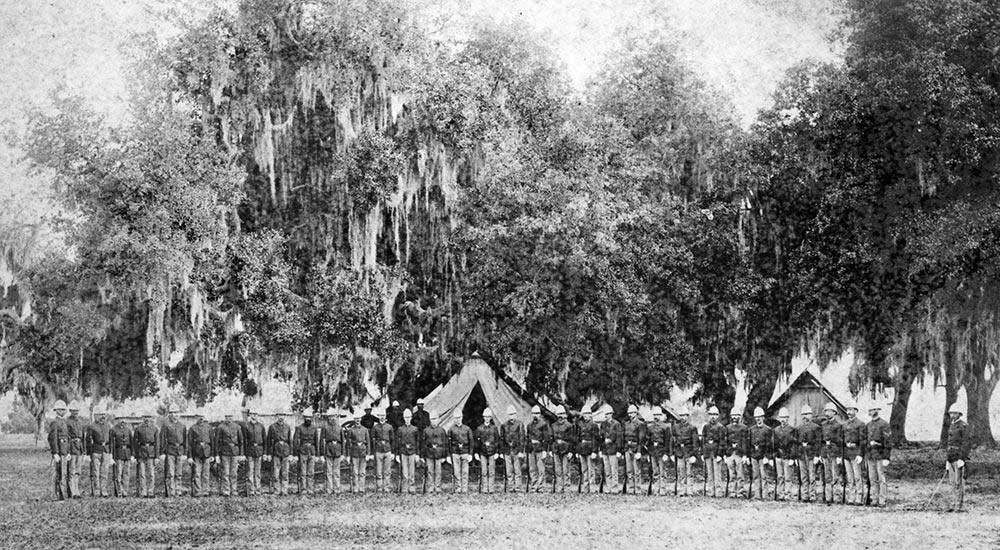
This
photo is from the USF
Digital Collection where it
is attributed to the Burgert
Brothers and dated "1880?"
It's not possible that the
Burgert brothers took this
photo. The oldest Burgert
brother was Willard Chesney
Burgert and would have been
5 years old in 1880. This
photo is part of the
Burgert's "Relic photo"
collection--photos they
bought from other
photographers.
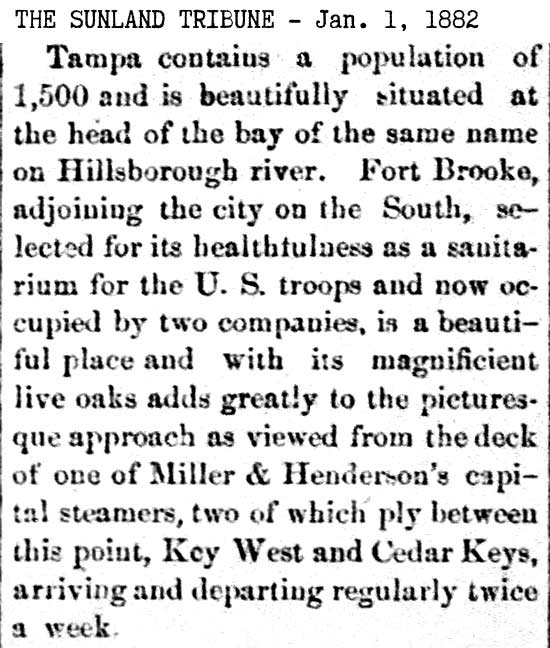
On December 24, 1880 the
Secretary of War authorized
the expenditure of one
thousand dollars for the
repair of the buildings and
detailed sketches of
proposed barracks buildings
planned for Fort Brooke can
be found in the military
records at the National
Archives.
KEY WEST TROOPS LEAVE FORT
BROOKE, POST IS
DECOMMISSIONED
The Sunland Tribune gives
Fort Brooke a glowing review
as if it was in a tourist
brochure.
The troops from Key West
remained in Tampa from May
1880 until 1882 when they
were transferred during the
"sick season" to St.
Augustine and Mount Vernon,
Alabama. The last roll call
of soldiers occurred in 1882
and the last soldiers were
shipped out in December the
same year. The post was
decommissioned by the US
Army in 1883. In 1883
the War Department
relinquished title to the
Interior Department and the
reservation was opened to
homestead applications at
the Federal Land Office.
This started "The
Final Battle for Fort
Brooke."
It wasn't annexed into Tampa
until 1907. |
FLORENCE HANFORD ON THE
1880 CENSUS
Living in the "Town of
Tampa" with her son, Willie
Ferris (13) who was
attending school, Florence
was still "housekeeping"
which indicated no
occupation for income.
This record indicates
Florence was divorced,
Charles Hanford is
nowhere to be found on this
census. The enumerator
was to record a slash (\) in
col. 11 if widowed, or write
a "D" in col. 11 if
divorced. The
appearance of a "D" could
therefore not be an
accidental careless mark by
the enumerator.
This was the first census to
record the birth place of
the person's parents.
It shows Florence's parents
were from North Carolina.
A search for Andrew J.
Hunter or Mary Hunter or
Mary Houston born in NC
yielded no conclusive census
results.
She lived near carpenter
John T Givens, James McKay
(Jr.), John McKay (his
bro.), editor & Publisher
Thomas K. Spencer,
blacksmith John H. Krause,
lawyer & editor James T.
Magbee, merchant John
Darling, merchant Wm. B.
Henderson, physician &
editor John P. Wall.
these are all early Tampa
pioneers who lived in the
heart of Tampa near Franklin
St. & Jackson, northward to
around Cass. St.
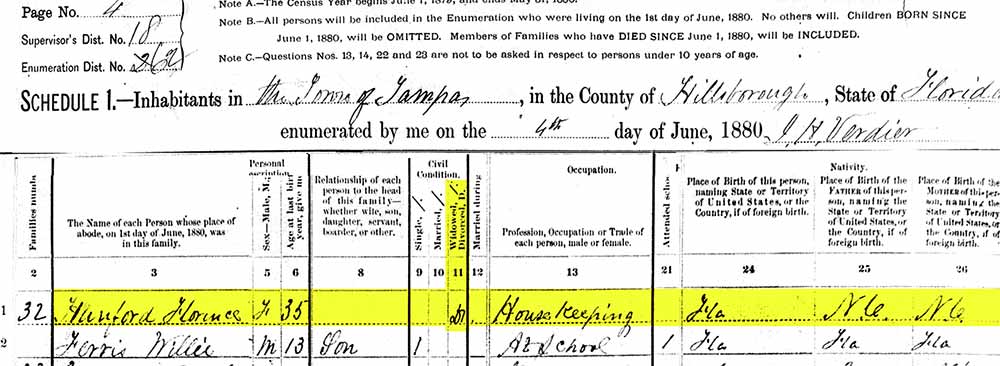
MENTION OF CHARLES HANFORD
IN TAMPA FOR 1885
According to
The City Clerks of Tampa,
2nd Ed., Sept 2017, Charles
Hanford was one of the
founding members of Tampa's
Board of Trade in 1885.
But in Karl Grismer's
history of Tampa, Hanford
is not among those listed
who attended the meeting
when it was organized on May
7, 1885. The initial
membership was dominated by
retail store owners (27 out
of 63 members.) There
are no Tampa newspapers
online for 1885.
According to Grismer:
The Board of Trade
was organized Thursday
night, May 7, 1885, at a
meeting of the town's
boosters in Branch's
Opera House. Dr. John P.
Wall was elected
president; John T.
Lesley, vice-president,
and Thomas A. Carruth,
secretary. Its first
members included
practically all the
progressive citizens of
Tampa. They were: E . P
. Seclor, H . Herman,
Edward A. Clarke,
Christophper. L.
Friebele, William. G.
Ferris (Sr.), George H.
Packwood, W . A.
Morrison, H. E.
Cleaveland, David. S.
Macfarlane, A. B. M
cKenzie, Lawson Chase,
George T. Chamberlain,
Dr. J. A. Giddens, Perry
G. Wall, II., H. L.
Knight, Silas. A. Jones,
A. J. Knight, I. S.
Giddens, W. C . Brown,
Thomas. C. Taliaferro,
J. H. Fessenden, Fred.
A. Salomonson, Thomas A.
Carruth, W. N. Conoley,
C . L. Ayres, J . A.
Campbell, S. B .
Leonardi, J. D Clarke,
Hugh. C. Macfarlane, A.
S. Lenfestey, Augustus.
C . Wuerpel, H. W.
Fuller, S. P. Hinckley,
Thomas E. Jackson,
Thomas. K. Spencer,
James McKay, Jr., J. V.
Brannan, Fred Ferman, D.
F. Hammond, H . J.
Cooper, Dr. George B.
Weedon, John T. Givens,
Dr. H. R . Benjamin,
John F . Browning, N.
Dixon, W. J. Allen, J.
H. Dorsey, Paul Jones,
W. S. Hancock, John B.
Spencer, J. T .
Anderson, Stephen. M.
Sparkman, William B.
Henderson, W. A. Givens,
William Hayes, Jr., F.
J. LaPenotiere, J. M.
Johnson, 0. J. Andreu, M
. Lovengreen, Dr. Duff
Post, E. L. Lesley, S. L
. Biglow, George B.
Sparkman, James T.
Magbee and J. E.
Mitchell. Unquestionably
the most important
achievement of the Board
of Trade was the part it
played in bringing the
cigar industry to Tampa.
(Some first names
have been added by
TampaPix.)
If the Tampa City Clerks
publication is correct,
Hanford was still in Tampa
in 1885 when the Board of
Trade was established. |
|
FLORENCE HANFORD ON THE
1885 STATE CENSUS
On the June 30, 1885
state census of Florida,
Florence Hanford was
recorded as widowed and
running a boarding house in
Tampa.
The question is, was she
first divorced and by 1880,
her ex-husband had died?
The first mention of her
boarding house in Tampa
newspapers is found in the
Weekly Tribune issue of Jun
16, 1888. The article
is a list of businesses and
their incomes for the one
week ending Jun 9th, 1888.
It shows "Mrs. Hanford,
boarding house, $20.
Over the next decade are a
about half a dozen mentions
of a visitor renting there.
The address 508 Twiggs was
her home.
 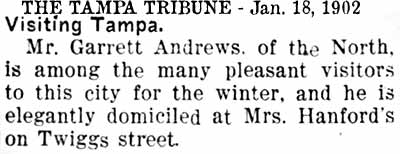
The first Sanborn Fire
Insurance maps to cover this
area of Twiggs Street was in
1895. The house was a
1˝ story wood frame
structure with a room
extended from the rear on
the northwest corner, and a
separate porch in the front
which was probably a direct
entrance to the room.
Florence's kitchen was
rather large for a house
this size. The east
side of the house faced the
west end of the Academy of
the Holy Names convent built
in 1891. It was
demolished in Oct. 1925 and
eventually became the site
of the City Markets in 1927.
Its last life was as a
U-Save supermarket from 1947
to 1991.
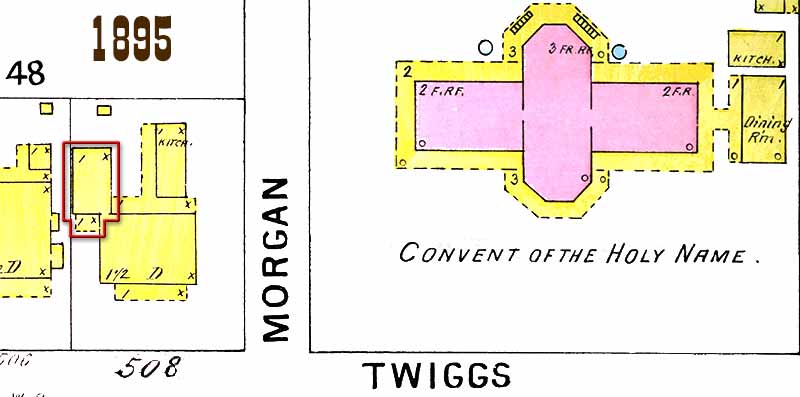
Morgan St. has been narrowed
in this image to conserve
horizontal space.
See a 1925 photo of the
convent taken just before
demolition from the location
of Florence Hanford's
property at Morgan St. and
Twiggs.
See a history of the convent
and the City Markets and
many old photos here at
TampaPix.
The 1885 Census shows
Florence at age 38, widowed,
and her occupation was
"Private boarding house."
In her home was only her
son, Willie F. Ferris
(incorrect middle initial.)
Enumerated three households
away was James McKay (Jr.),
"sea captain," and his wife
Mary E. and their six
children. Next to the McKays
were W.G. Ferris (Sr.)
merchant, (73) with wife
Eliza M. (67) and daughter
Alice C (12).
.jpg)
|
|
WHF married
Katherine Elizabeth Craig
in Tampa on Feb. 15, 1894.
He was a shoe merchant with
Ferris & Blain in Tampa from
1892 to 1899, and after a
short time in a Navy
mercantile company, he
became a furniture salesman
in 1902. By 1904 he moved to
Birmingham and continued a
successful furniture
business there where he was
joined by his mother in
1909. His wife
remained in Tampa all her
life and would visit him now
and then, sometimes with
their daughter. Mrs.
Ferris was a piano teacher
and talented performer for
many years in Tampa.
She was the first and only
president of the Friday
Morning Musicale in Tampa
for its first 20+ years
until her death in 1924.
She and WHF had only one
child, Katherine Norman
Ferris, her middle name
being her uncle's, Norman W.
Craig.
|
|
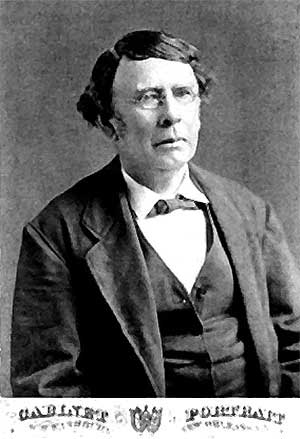 |
Eliza (Morris) Ferris died
in Tampa, Oct. 31, 1891.
William. G. Ferris Sr. died
in Tampa, Aug. 3, 1895,
after a long and productive
life.
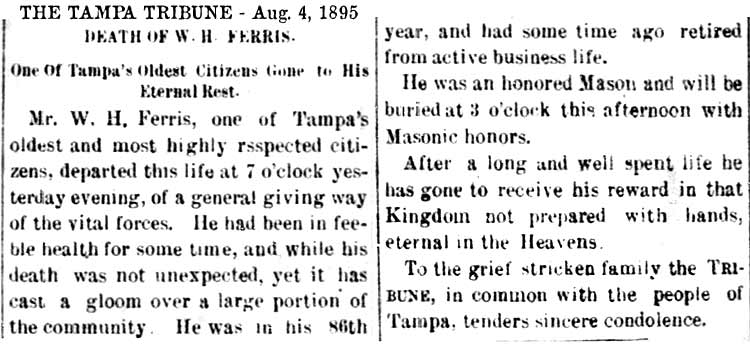 |
|
William
Gould Ferris, Sr.
photo from Sunland Tribune
Vol. 22, 1996 "Tampa
Is The Place of Places"
by Kyle Vanlandingham, at
USF Library Digital Commons. |
See
TampaPix Tampa & James McKay
during the Civil War and
Tampa during the 1848
Hurricane.
|
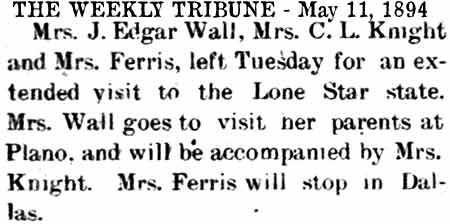
WILLIAM HOUSTON FERRIS
AND WIFE KATE CRAIG FERRIS
Three months after marrying
W. H. Ferris, Mrs. Ferris
(Katherine Craig Ferris) was
off to Dallas, probably to
see her parents.
Meanwhile, Mr. Ferris was
busy with his shoe store.
|
|
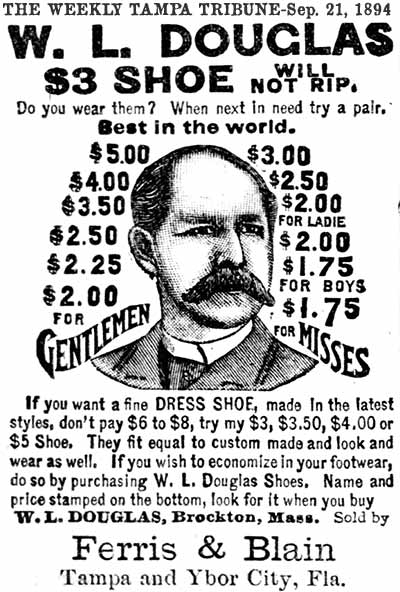 |
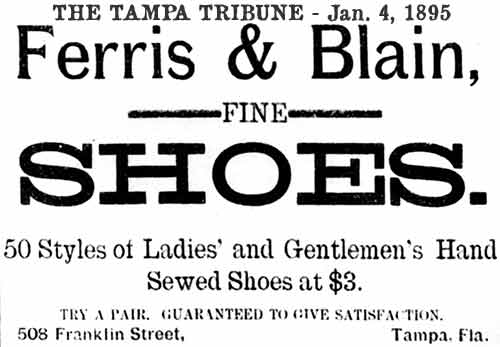 |
FERRIS & BLAIN MOVES 2
BLOCKS NORTH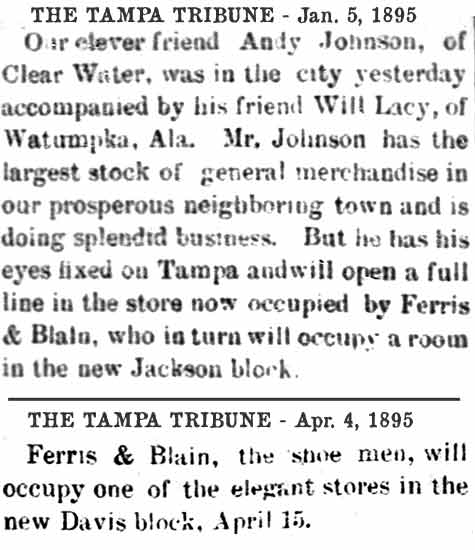 |
| |
|
|
|
1892 - Ferris & Blain shoe
store in the 2-story brick
Gould Building at 508
Franklin St. "B & S" was
"boots & shoes." There
was a dentist on the 2nd
floor. Yellow
buildings were wood frame. |
1895 - Ferris & Blain shoe
store on the Davis Block at
708 Franklin St. (outlined
in red) in 1895. The
building outlined in blue
was 3 stories and being
built at the time the map
was planned. In 1926
the Tampa Theater was built
across Franklin Street,
replacing the two brick
buildings seen here. |
|
 |
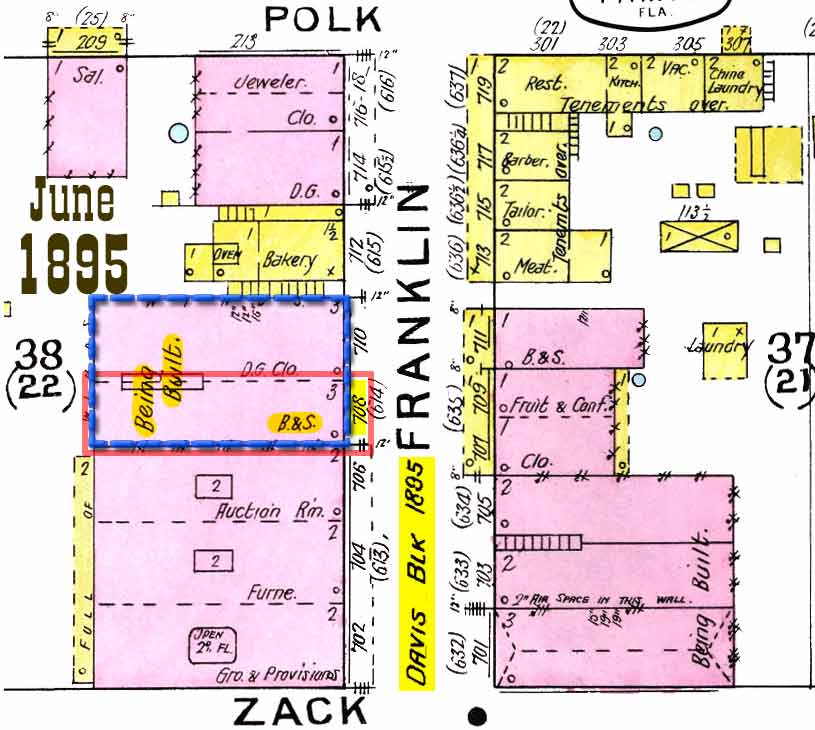 |
| |
|
|
WHF traveled often to
purchase shoes for his
business. In 1895 his
partnership with Eugene
Blain was mutually dissolved
due to Blain becoming
general manager of a lumber
company.
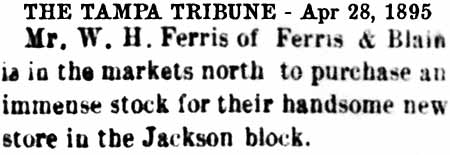 |
 |
|
The first mention of Mrs.
Ferris' musical talent is
found in the Dec. 8, 1895
Tampa Tribune.
She was in the news hundreds
of times in her lifetime
concerning various public
performances on the piano
and pipe organ in funerals,
weddings, shows and society
club meetings. |
 |
|
After mutually dissolving
their Ferris & Blain
partnership, W.H. Ferris
continued in the shoe
business for four more
years.
|
|
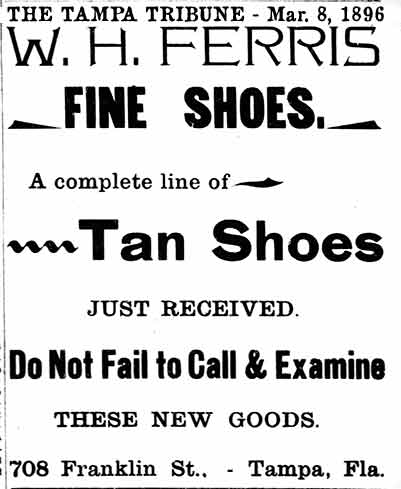 |
 |
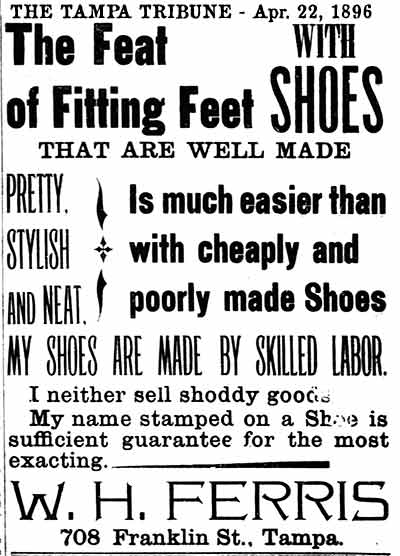 |
|
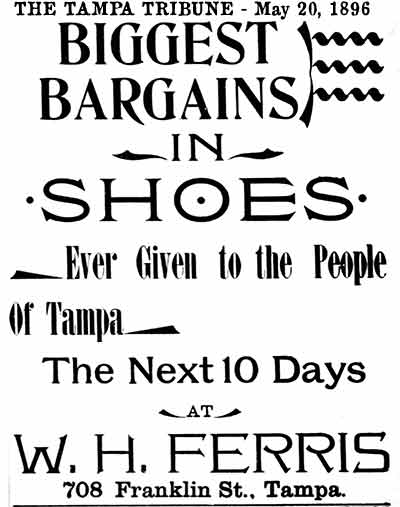 |
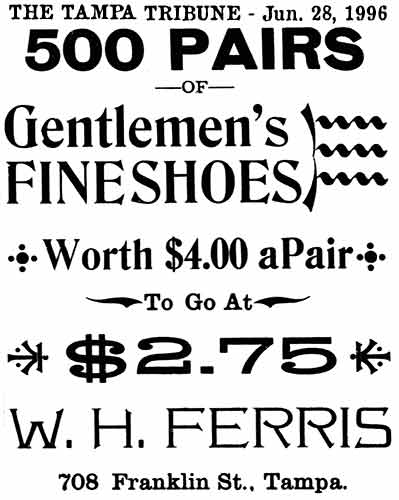 |
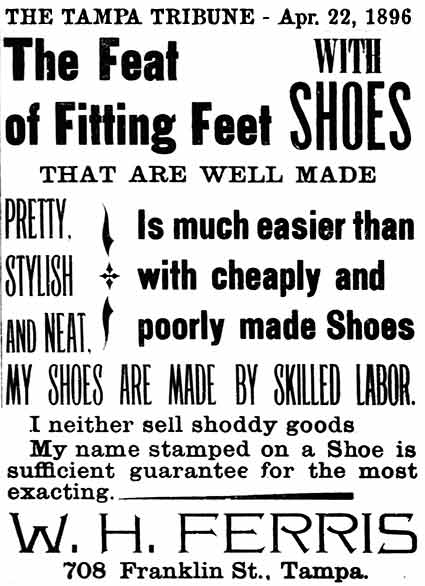 |
|
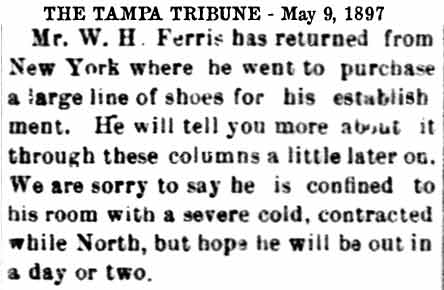 |
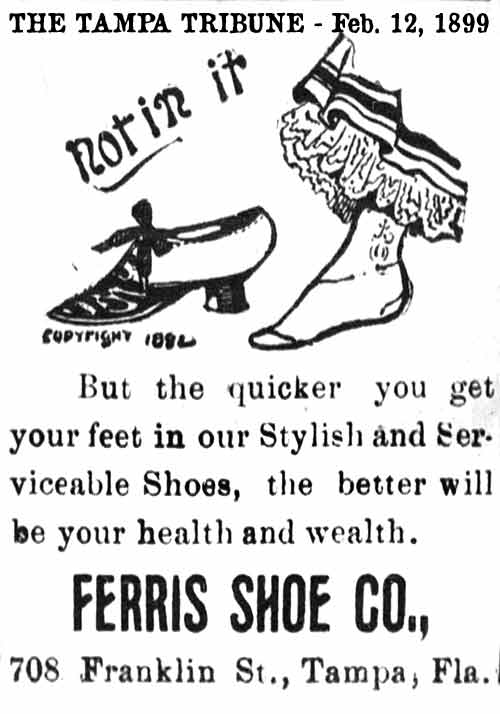 |
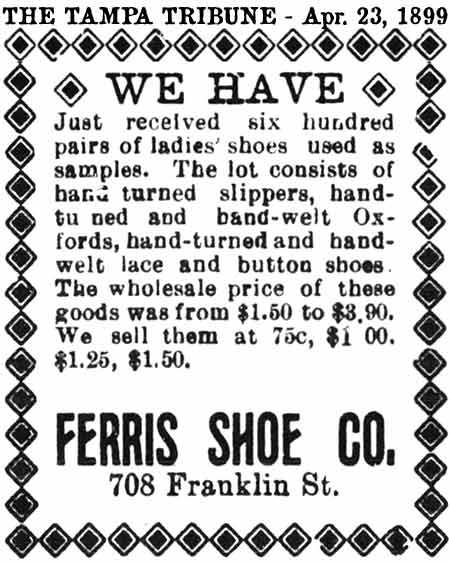 |
|
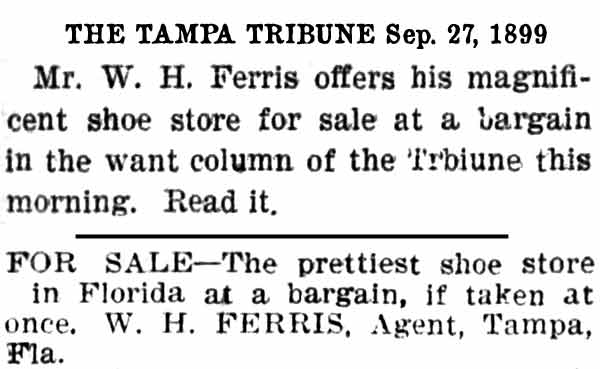
|
He then sold his shoe
business to H.T. Vatterlin
in late September of 1899.
It was expected that Mr. &
Mrs. Ferris would soon move
up north, but only part of
this would be correct. |
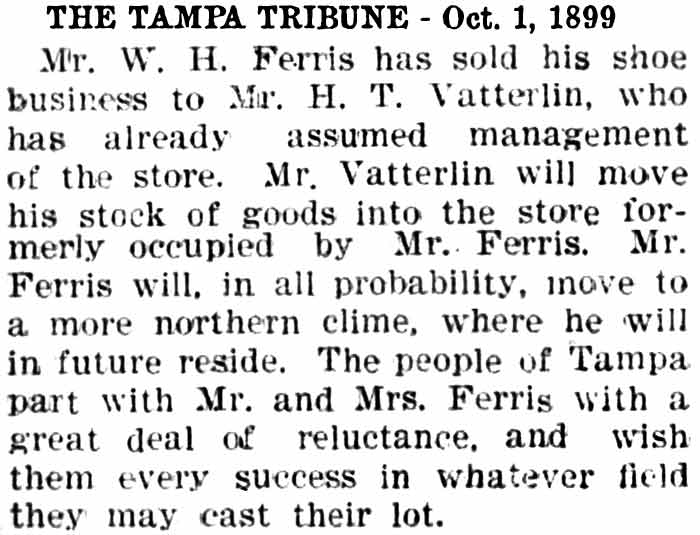
|
|
There was a mob scene at the
store when Vatterlin put all
of Ferris's inventory on
sale for drastically reduced
prices. Vatterlin had to
shut the doors and let one
person in at a time as one
person left. |
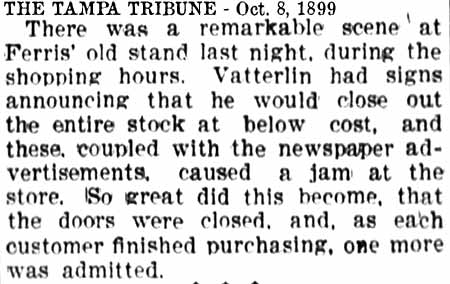 |
Mr. Ferris did some
travelling after
he sold his store.
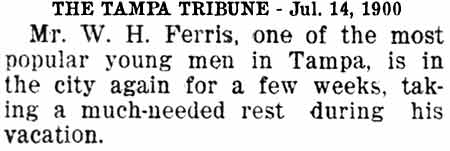
|
|
Without any prior mention,
W. H. Ferris had joined C.P.
[sic] Baker at his Tampa
Naval Stores.
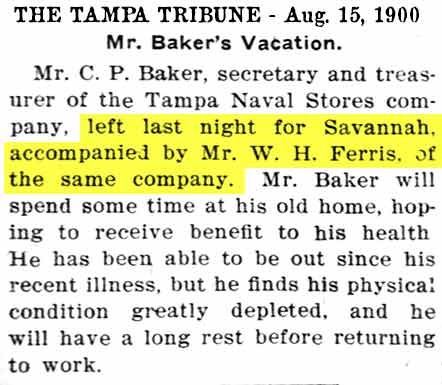 |
Tampa Naval Stores Co. filed
for incorporation in Oct 1899 with
$100k capital stock. The company was
to engage in extensive naval stores
business, with Tampa & Port Tampa as
its principal business points.
T.A. Jennings Pres, DeSoto
Fitzgerald VP, C.B. Baker sec. &
treas. Other incorporators were M.J.
Wood, C.A. Jacobson.
Incorporation completed Nov. 8, 1899
in Tallahassee, "to conduct business
of naval stores merchants, general
commission and factorage business in
naval stores, farm products,
operating naval stores, sawmills,
tram roads, steam boats, deal in
real and personal property and
conduct a storage and wharfage
business." After initial raging
success, the company went out of
business in 1905 due to a rise in
railroad freight rates, with
corporate leaders leaving for other
companies due to the decline of the
turpentine business in Tampa and its
relocation to Jacksonville.
The company reorganized
in Oct. 1905. |

TFC had been around since at
least 1890, located on the
"Arnold block" of Franklin
St.
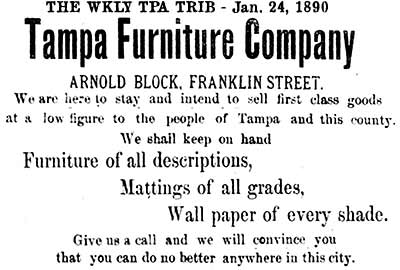
|
 |
"Knight of the grip" was
slang for a traveling
salesman.
After this, W. H. Ferris is
mentioned a few more times
in Tampa newspapers (1904,
1905 & 1909, see timeline
below).
He moved to Birmingham, Ala.
before 1904 and started a
furniture business there.
His wife and daughter
remained in Tampa. |
FERRIS FAMILY TIMELINE
|
1850 Jun 01 |
Census of Tampa lists
children of Wm G. Ferris (39)
and Elizabeth Ferris (30):
Josiah, 13 (1834-35); Mary;
William, 6 (1843-44); Ann
Eliza, 4 (1845-46); and Henry C,
2 (1847-48). |
|
1860 Jun 01 |
Census of Tampa
shows William Ferris (Jr.)
age 16, living in the home of his
parents W.G. (49) and Eliza Ferris
(43).
William G. Ferris, Jr, b. Jul 29,
1844, d. Jul 27, 1867 buried in
Tampa's Oaklawn Cemetery.
Eliza (14), Henry C. (10), Alice
(6).
|
|
1865 May 25 |
Marriage #1362 Leon County,
William G. Ferris and
Florence A. Hunter |
|
1870 Jun 01 |
Census, Tampa -
Susan
F. Ferris 25 (b. c1845,
Fla.), William H.
Ferris 3, b. Fla.
She has a 30 yr old black
servant cook Rachel and real
estate $1500 and personal
property $500. This is
more than most men on the
page and surrounding pages.
She was no poor widow.
It is assumed that William's
mother was Susan Florence
Ferris as on later records
she is "Florence."
|
|
1870 Sep 01 |
Marriage license, Tampa,
Mrs. Florence Ferris and
Charles Hanford, married by
Wm E. Collier, Matt P. Lyons
clerk of Ckt Ct. |
|
1870 Sep 06 |
Katherine Elizabeth Craig
born in Orrville, Ala. to
Emmit E. Craig & Mary
Kittrell Craig |
|
1880 Jun 01 |
Census of Hunt Co, TX - E.E.
Craig (36) Grocer, M.K.
Craig, wife (36) Katie,
daughter (9), and son N.W.
Craig (8, Norman.) |
|
1885 Jun 30 |
Florida Census, Hillsb. Co -
Florence Hanford 38,
widowed, private boarding
house, son William 18 |
|
1894 Feb. 15 |
Marriage of William H.
Ferris and Katherine E.
Craig, Tampa. |
|
1895 Feb. 20 |
Daughter Katherine Norman
Ferris born in Tampa.
Middle name for mother's
brother. |
|
1895 Nov. 02 |
TRIB: Mr. W.H. Ferris
continues shoe business at
the same old stand after
Blain of Ferris & Blain
dissolves partnership
mutually. |
|
1897 Aug. 19 |
TRIB - W.H. Ferris
president of Tampa Wheelmen
bicycle club.
|
|
1898 Mar 18 |
TRIB - Hyde Park Tea
Guild meets at residence of
Florence Hanford, 508
Twiggs. This is William's
mother, Florence Hunter
Ferris Hanford. |
|
1899 Sep 28 |
TRIB - Mrs. W. H.
Ferris and little daughter
return from Atlanta |
|
1900 Feb. 04 |
TRIB - An event
was held at the home of Mrs.
Hanford on Twiggs St. and
was the "center of
attraction for society's
queens...when Mrs. W. H.
Ferris graciously received
her young friends." |
|
1900 June 01 |
Census, Tampa,
William (32), b. Jan 1868
Fla, wife Katherine (28),
dau Katherine (5).
They were living in home of
his widowed mother at 508
Twiggs St, Florence Hanford
52. He was owner of shoe
business, Katherine was a
music teacher.
The 1900 Census recorded
birth month, year, and age.
William's birth year and age
are incorrect. If he was
born in January it would
have been in 1867 because he
was 3 on the June 1, 1870
Census. He would have
been 33 on the 1900 Census. |
|
 |
|
1902 Jan 02 |
TRIB - Mr.
W. H. Ferris is now with the
Tampa Furniture Co.
|
|
1904 Jul 29 |
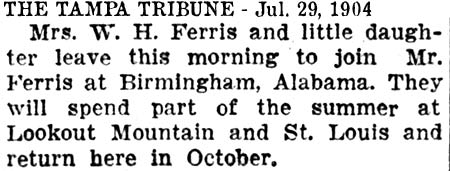 One
of two articles that
mentions Mr. & Mrs. Ferris
together. One
of two articles that
mentions Mr. & Mrs. Ferris
together.
Kate and her daughter left
Tampa to join Mr. Ferris in
Birmingham. They were
to spend part of the summer
at Lookout Mountain and St.
Louis before returning to
Tampa in October. |
|
1905 Sep 26 |
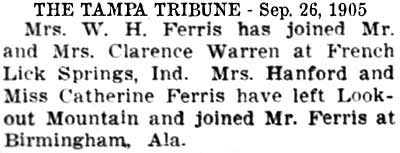 The
second article that mentions
Mr. & Mrs. Ferris.
Mrs. Ferris often vacationed
in the Carolinas or
elsewhere in the north each
summer, usually with her
daughter, but not every
time. Here, only
William's mother and
daughter come visit William
in Birmingham while his wife
visits friends in Indiana
after having spent time at
Lookout Mountain in NC. The
second article that mentions
Mr. & Mrs. Ferris.
Mrs. Ferris often vacationed
in the Carolinas or
elsewhere in the north each
summer, usually with her
daughter, but not every
time. Here, only
William's mother and
daughter come visit William
in Birmingham while his wife
visits friends in Indiana
after having spent time at
Lookout Mountain in NC. |
|
1907 Jan 12 |
Birmingham, Ala.
Post-Herald: W.H. Ferris
starts appearing in
Birmingham newspapers,
elected as member of the
Birmingham Commercial Club,
then in ads for his
furniture store. |
|
1908 Jul 03 |
Birmingham News: W.
H. Ferris WANT AD - To rent
a warehouse of buy a lot on
Belt RR. W.H. Ferris,
2121˝ 3rd Ave. |
|
1908 Aug. 02 |
Birmingham Post-Herald:
W. H. Ferris WANT AD
Salesmen to sell furniture
as a side line to dealers. |
|
1908 Aug 09 |
Birmingham Post-Herald:
Oct. 1 one room 50 x 200 ft;
large electric elevator and
private RR track. |
|
1909
Jan 01 |
Birmingham News: NEW
CORPORATIONS - "W. H. Ferris
Furniture Company" filed in
the Probate Court.
Authorized capital stock at
$5,000, fully subscribed and
paid up. Officers are:
K. C. Ferris, president
(this is Kate Craig Ferris,
William's wife); F. H.
Hanford, vice president &
secretary, (Florence Hunter
Hanford, William's
mother); W. H. Ferris,
treasurer & manager. Kate's
and Florence's involvement
with the company appear to
be only a matter of William
obtaining corporation status
as neither of them ever seem
to mentioned in the news as
being involved with the
company. |
|
1909 Nov. 11 |
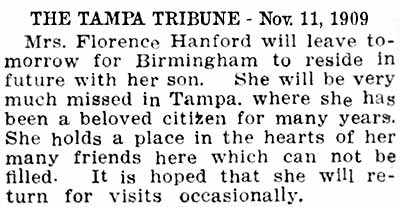
TRIB - Florence Hanford
is moving to Birmingham to
live with her son. |
|
1910 Apr 15 |
Census of Birmingham, Ala.
W. H. Ferris was living with
his 60 year old widowed
mother, Florence Hanford.
He was 42,* born in Fla.,
married for 16 years,
furniture store merchant,
but his wife is not in the
home. He was born Jan.
1867, he would have been 43
by April 15, 1910. |
|
1910 Apr 15 |
Kate Ferris does not appear
under any name on the 1910
Census or in the 1910 Tampa
City Directory. |
|
1911 Jun
13 |
Birmingham News -
W. H Ferris WANTED - To
buy, sell or exchange
second-hand furniture; also
to pack and ship household
goods. 2113 2nd Ave,
2121˝ 3rd Ave.
|
|
1911 Jun 23 |
Birmingham News - -
FOR SALE at factory cost,
100 sample iron beds.
W.H. Ferris, 2121˝ 3rd Ave. |
| |
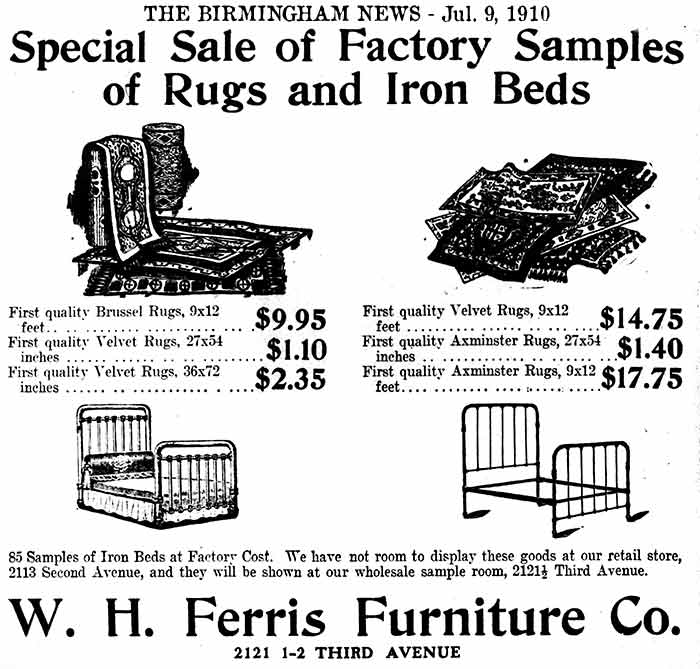 |
|
1911 Jul 30 |
TRIB - Mrs. W. H
Ferris traveled to
London with mother Mrs.
Craig of Texas to attend
royal opera. |
|
1913 Sep 21 |
TRIB AD - PIANO AND PIPE
ORGAN - Mrs. W.H.
Ferris, organist and
director of St. Andrew's
choir, teacher of piano,
(Sherwood), pipe organ,
(Flagler). Trained
accompanist, coaching of
best masters abroad.
Phone 1327 or 498.
Florida Open Air School. |
|
1914
Jul 16 |
TRIB - Miss
Katherine Ferris,
who has been the guest of
her (paternal) grandmother,
Mrs. Florence Hanford, is
now visiting in New York.
Later Miss Ferris will take
a motor trip through the
Adirondacks, Catskills and
into Canada before entering
Sweet Briar, where she will
attend school next year. |
|
1914 Sep 22 |
Annette Sperry succeeds
Mrs W. H Ferris who
resigned as St. Andrew's
organist |
|
1914 Oct 23 |
Birmingham News -
Mrs. William Ferris spent
some time with relatives in
Dallas, TX and now visiting
her mother [in-law] Mrs.
Hanford, on 11th Ave So.
before returning to her home
in Tampa. |
|
1918 Jul 29 |
Florence Hanford, mother of
W.H. Ferris, died in
Birmingham on July 29, 1918.
Her obits say she was 76.
She was at most 73.
Florence's parents married
in Leon Co., Tallahassee on
Jan. 25, 1844.
Assuming Florence was born
no less than 9 months later,
she would have been born in
Oct. 1844. Her
1860 Census age of 15 puts
her birth at 1844-45.
Her 1870 Census age of 25
also puts her birth at
1844-45. Her 1880
Census age of 35 also puts
her birth at 1844-45.
As time passes, a person's
age becomes unreliable on
censuses. Her
1900 Census age is
incorrect, it says she was
52, BUT it shows she was
born Oct. 1847. The
census date was June 1, so
the math was probably done
to arrive at 1847. Her
birth month of Oct. being
reliable, it shows she was
born 9 months after her
parents married. . In
1910 she was listed at 60;
she would have been 64.
In Oct. 1918 she would have
turned 74, but she died in
July, so she was 73.
She was buried in Tampa's
Woodlawn Cemetery. Her
obit of July 31 in the
Tribune "Roll of the Dead"
says she had lived in
Birmingham for four years.
This is incorrect; she moved
there in 1909 and she and
her son are on the 1910
census of Birmingham so she
had lived there at least 9
years. It mentions she
had a boarding house in
Tampa after her husband's
death "many years ago."
Information about her
boarding house has already
been presented above.
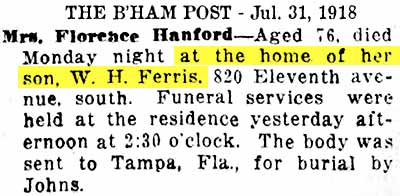
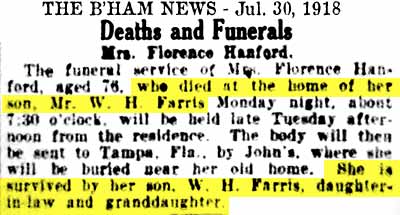
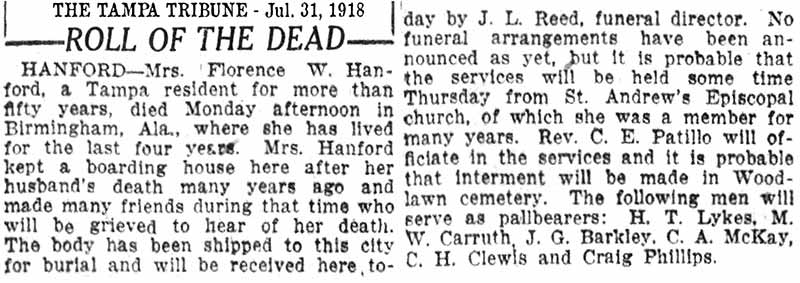
|
|
1920 Jan 01 |
Census, Birmingham -
W. H. Ferris age 60*, owns
furniture shop, rooming at
rear of house at 1020 11th
Ave, home of Fred Patterson
(oil promoter) & family. *WHF
was born Jan. 1867.
He would have been 53 on
Jan. 1, 1920, or 54 if he
was born Jan. 1. |
|
1920 Jan 01 |
Census, Tampa, 712
Fielding Ave - Kate C.
Ferris 47 married, Music
teacher at home, dau.
Catherine 24, single,
private school teacher.
Kate would have been 49 on
this census. The
highlighted columns were for
home ownership or rental,
and mortgaged or free (paid
off.) It shows she was
a home owner, mortgaged. |
 |
|
1920 Nov 24 |
TRIB - Trial of Mr.
McDuffie for fatal auto
accident colliding with
Lizzie Carew who was driving
her car. Passengers
with Carew were Mrs. W. H.
Ferris and Miss Catherine
Ferris |
|
1921 Sep 02 |
TRIB - Death of
Mrs. Mary Kittrell Craig,
mother of Mrs. W. H. Ferris
and grandmother of Miss
Catherine Ferris of Tampa,
died in Dallas TX Aug
31. |
|
1924 May 03 |
TIMES - Mrs W.H.
Ferris, founder of Friday
Morning Musicale, is
director of St. Andrews
choir.
|
|
1924 Aug 27 |
TRIB - Rotary meeting
Dr. Patillo reads message of
thanks from Mrs. W, H.
Ferris (for flowers) who
is undergoing long illness. |
|
1924 Sep 02 |
TRIB - Kate C.
Ferris, wife of William
Houston Ferris, died on Sep.
1, 1924 after a three months
illness (breast cancer.)
See her death certificate.
Though they were married,
her obits do not mention her
husband, William Houston
Ferris, among the survivors.
Only mentions are her
daughter Katherine, her aunt
Mrs. Byron (Elizabeth Craig)
Phillips, her cousins
Kathleen & Craig Phillips
(all four of Tampa) and her
brother, Norman Craig of
Dallas.
 |
|
1924 Sep 02
|
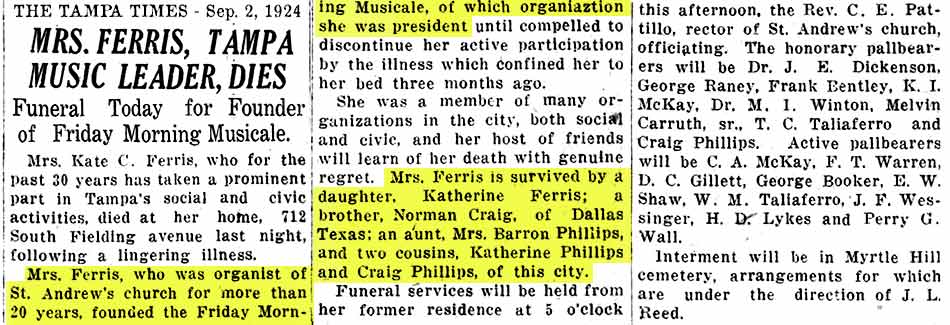
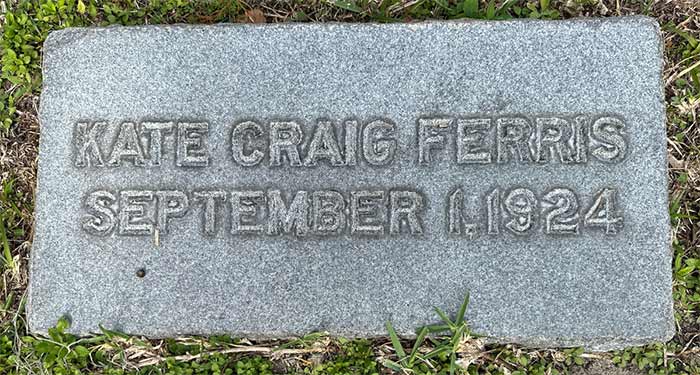
Myrtle
Hill cemetery
Photo from Find a Grave |
|
1924 Sep 03 |
TRIB
- DEATH OF KATE C.
FERRIS, The Rotary club
meeting "paid a silent
tribute of respect to the
memory of Mrs. Kate Ferris,
who had often played for the
club luncheons and other
affairs. Mrs. Ferris
died late Monday night" |
| |
|
|
1924 Sep 03 |
 |
1929 Mar 27
Wednesday |
Death of William Houston
Ferris in Birmingham, Ala. |
1929 Mar 28
Thursday |
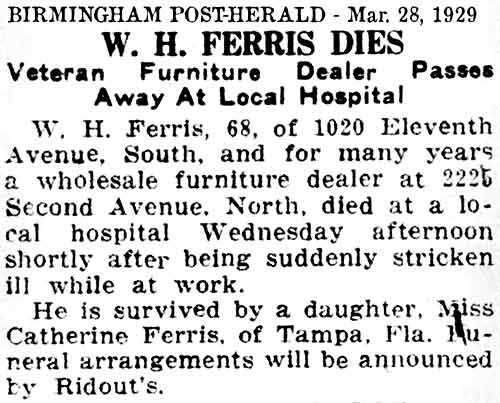 Birmingham
Post Herald:
Veteran Furniture Dealer
Passes Away at Local Hospital. Birmingham
Post Herald:
Veteran Furniture Dealer
Passes Away at Local Hospital.
W. H. Ferris, age 68*,
of 1020 Eleventh Ave. So.
and for many years a
furniture dealer at 225
Second Ave. No. in
Birmingham, died at local
hospital shortly after being
stricken ill at work.
He is survived by a
daughter, Miss Catherine
Ferris, of Tampa, Fla.
*WILLIAM FERRIS WAS NOT 68.
His 1870 census age of 3
means he was born sometime
from
June 2, 1866 to June 1,
1867.
He died on Mar. 27, 1929, so
if he was born on June 2,
1866 to March 27, 1867,
would have been 62. If
he was born on Mar. 28, 1867
to June 1, 1867, he would
have been 61.
Assuming his birth month of
January on the 1900 Census
is correct, he would have
been born Jan. 1867 and
would have been 62 when he
died and 6 months old when
his father died.
|
1929 Mar 29
Friday |
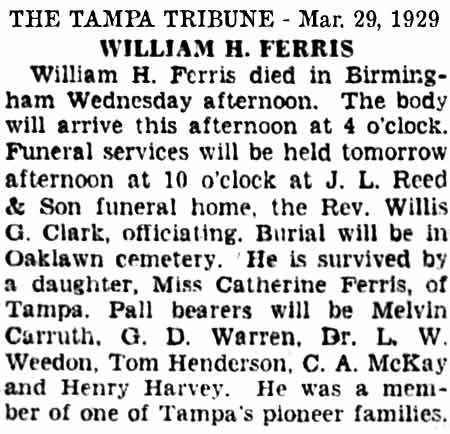 Tampa
Tribune - The body of William H. Ferris to
arrive in Tampa. His only survivor was his
daughter, Miss Catherine Ferris. Tampa
Tribune - The body of William H. Ferris to
arrive in Tampa. His only survivor was his
daughter, Miss Catherine Ferris.
|
| |
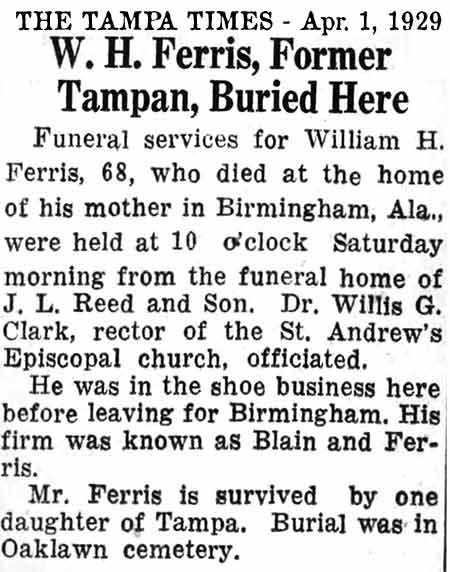 The
funeral of W.H. Ferris held
Mar. 30 in Tampa. The
funeral of W.H. Ferris held
Mar. 30 in Tampa.
THE TAMPA TIMES:
Died in Birmingham (yes)
at home of his mother (NO,
she died in 1918.).
Was in shoe business as
Blain & Ferris in Tampa
before leaving for
Birmingham. (NO,
was in furniture business.)
Survived by daughter.
Buried in Oaklawn Cemetery,
Tampa.
Though W. H. Ferris and Kate
were married, they seem to
have lived separate lives
beginning around 1902 to
1904. Kate led the
life of a socialite in
Tampa, as did her
mother-in-law Florence.
They travelled often, at
least once Kate touring
Europe with her mother Mrs.
Craig. For all the
events Kate hosted, and her
many travels all over the
country each year, it
doesn't seem possible that
she was living only off her
piano teaching classes.
She was probably at least
partly being supported by
her husband's furniture
business income.
|
DAUGHTER KATHERINE NORMAN FERRIS
Daughter Katherine/Catherine N. Ferris never
married and continued living at 712 Fielding
Ave. She became a school teacher after
attending Sweetbriar College in Canada from
1915.
-
Apr. 1, 1930 Census, 712 Fielding
Ave, Tampa - Catherine N. Ferris,
34, single, public school teacher.
-
Apr. 15, 1940 Census, 712 Fielding
Ave, Tampa - Catherine N. Ferris,
45, single, public school teacher,
lodgers: Verla Hennessee, 42,
single, public school teacher, June
Trezevant, 54, single, Industrial
bank teller.
-
1945 Florida state census, 712 S.
Fielding, Catherine Ferris, 50,
college educated, teacher. Charles
Roberts, 25, b. ME, Army, Mary
Roberts, 23, b. ME, housewife.
-
1950 Census, 712 S. Fielding,
Catherin N. Ferris, 55, never
married, public elementary primary
school teacher.
-
Jun 11, 1987 - Obituary, Catherine
Norman Ferris, 92, of 3405 Bay
to Bay blvd, Tampa, died
Wednesday Jun. 10, 1987. A
descendant of a pioneer Tampa
family, she was a lifelong resident
of the Tampa Bay area. She was
a retired public school teacher and
a member of Hyde Park Presbyterian
Church. Survived by three
cousins, Bernhard and Maggie Croft
both of Tampa, and Esther Floyd of
Haines City. JL Reed & Son
funeral dirs. (These cousins
must have been on her mother's side
because her father was an only
child.)
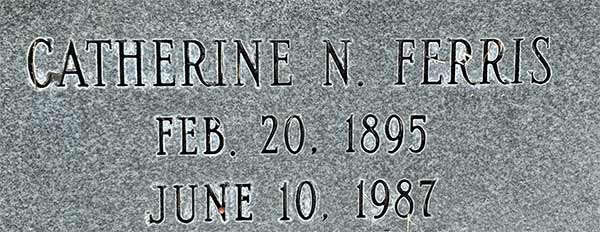
Photo from Find a Grave.
THE FRIDAY MORNING MUSICALE CELEBRATES ITS 50
YEAR ANNIVERSARY
| |
|
|
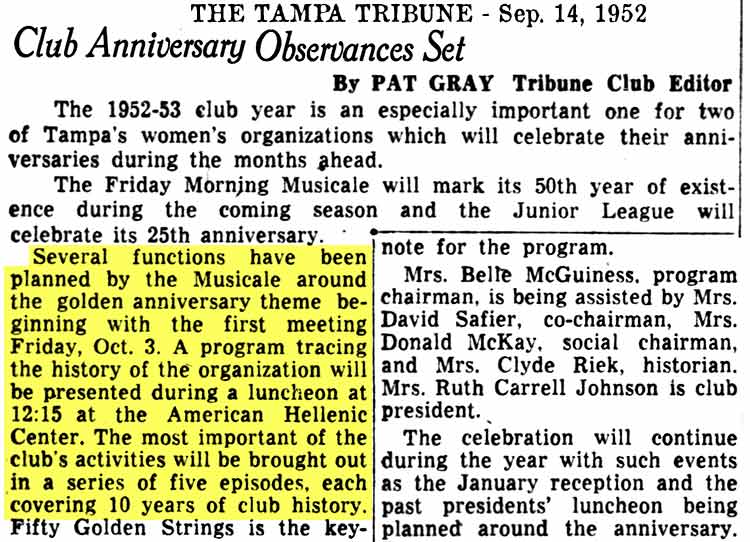 |
1952, Sep.
14
In 1952 the
Friday Morning Musical planned five meetings to celebrate
its fifty year anniversary. The first event one was to
be held on Oct. 3, 1952, at the American Hellenic Center. |
|
 |
|
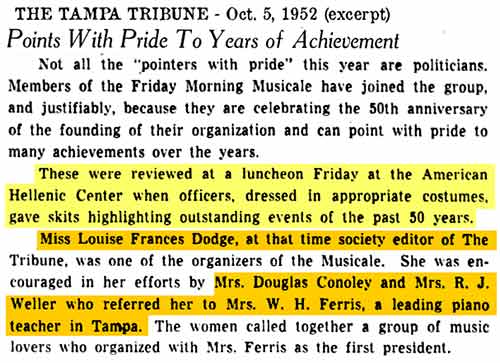
|
On Oct. 5,
1952, the Tribune published this full page article about
what transpired at this first event. Officers of the
club "dressed in appropriate costumes" presented skits
reenacting the outstanding events of the club's past fifty
years.
Charter members present (members of
the club when it was first
organized) included Mrs. Annie
Macfarlane McPherson, who was a
daughter of Hugh Macfarlane, now
remembered as "the father of West
Tampa," responsible for the initial
founding and growth of West Tampa as
a city.
Credit was given to
Louise Frances Dodge as
being one of the
organizers of the club.
She was "encouraged in
her efforts by Mrs.
Douglas Conoley and Mrs.
R.J. Weller who referred
her to Mrs. W.H. Ferris,
a leading piano teacher
in Tampa."
|
|
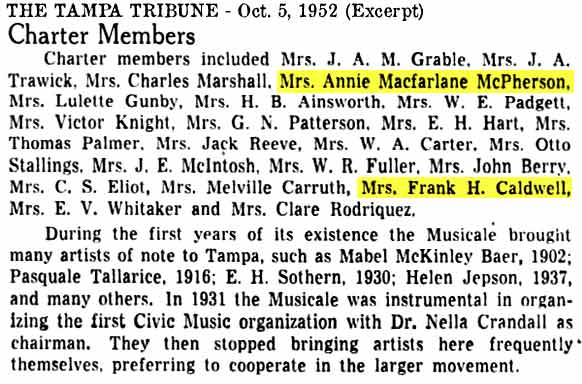 |
Annie Macfarlane was a
daughter of Hugh
Macfarlane, "the father
of West Tampa."
Annie was well-liked and
very talented as a
vocalist and pianist,
giving many local
performances that
elicited rave reviews in
Tampa.
Mrs. Frank Caldwell,
also known as "Mrs. Mary
Spencer Caldwell," wrote
a paper which was
recited by another
member, due to Mrs.
Caldwell's failing
vision, concerning the
life of Miss Louise
Frances Dodge.
This was reported by D.B.
McKay in his May 31,
1953 Pioneer Florida
page. |
|
|
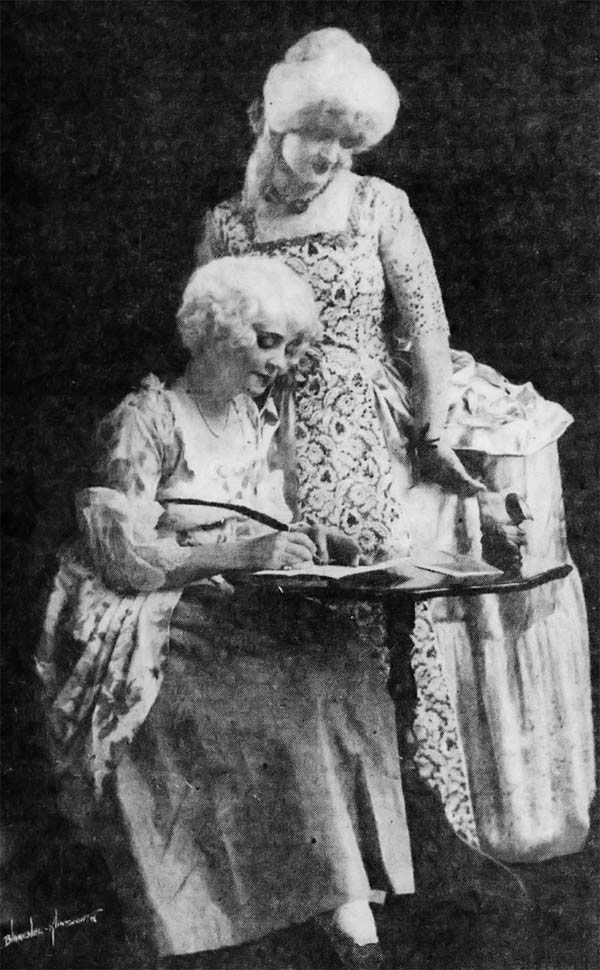 |
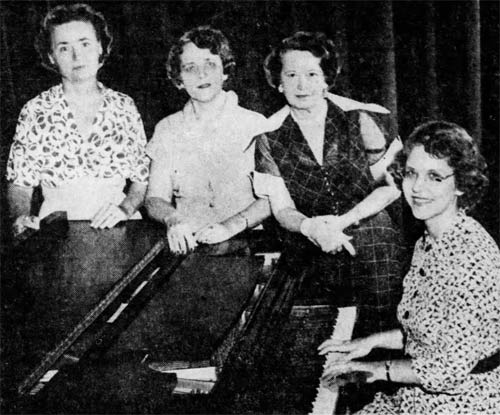 
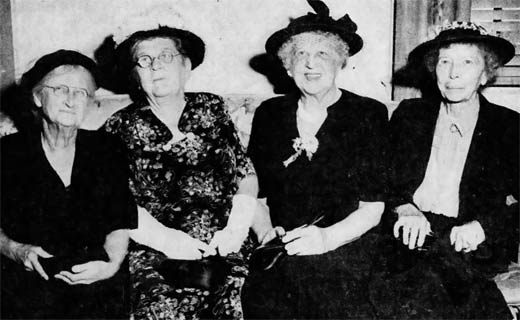
 |
|
 |
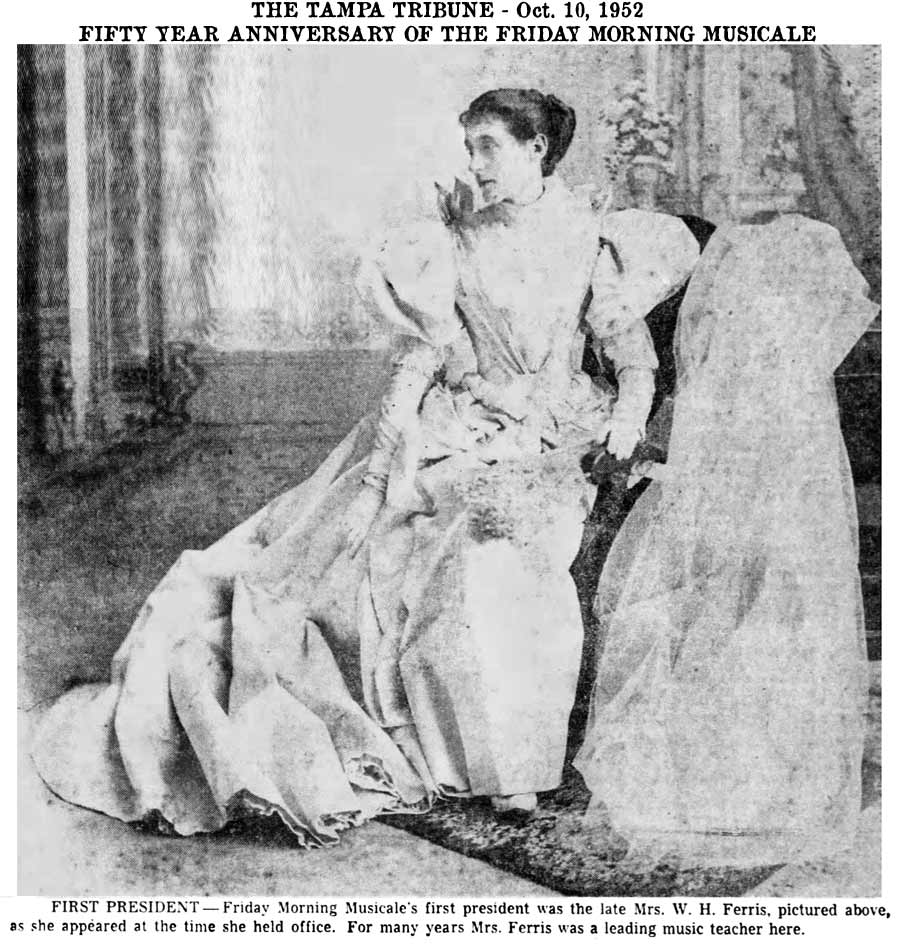 |